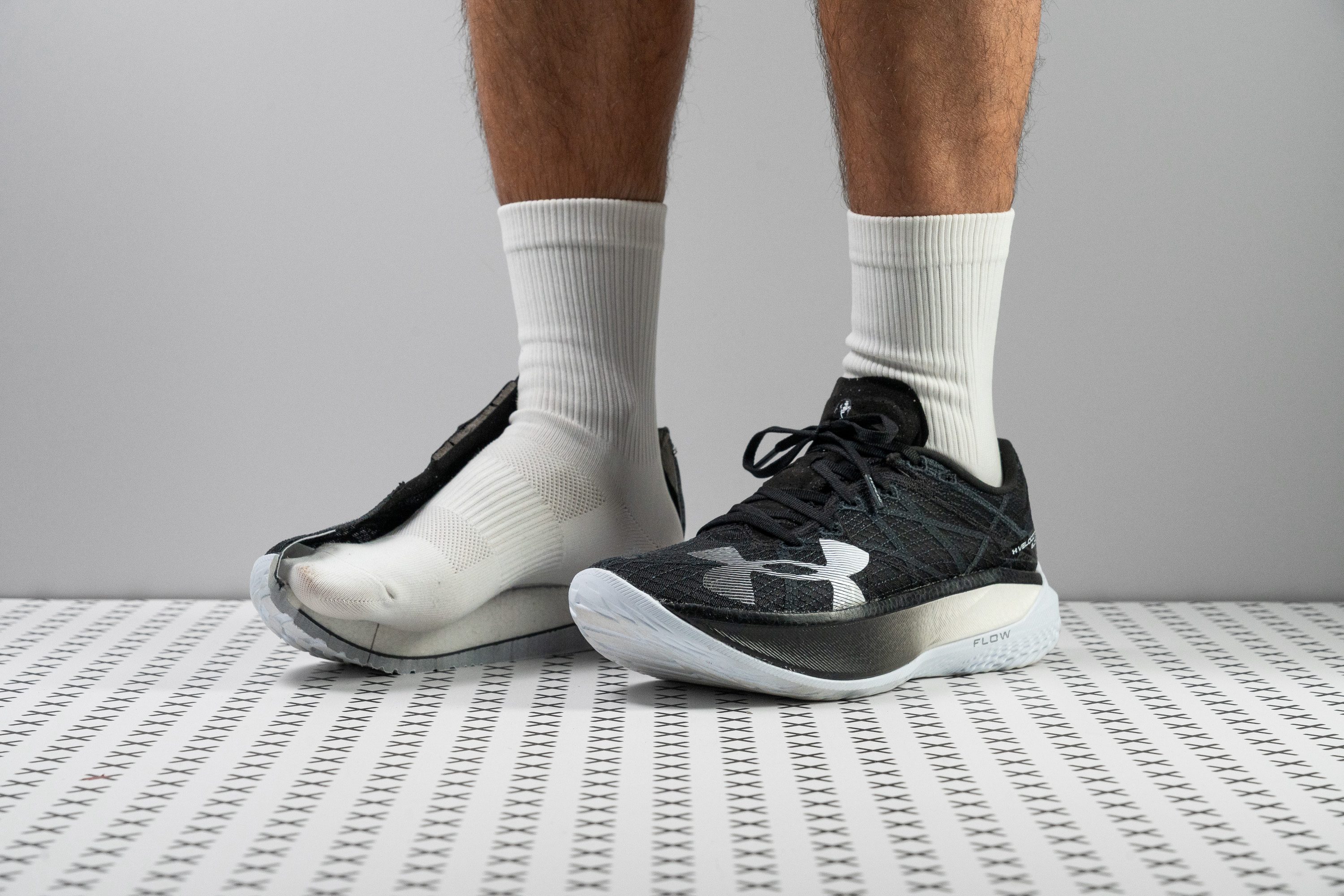Nuestra conclusión
Pros
- Upper muy transpirable
- Retorno de energía altísimo
- Tracción sólida
- Muy buen agarre en superficies secas
- Parte delantera ancha (para ser un modelo de competición)
- Transiciones suaves para los corredores de mediopié
- Cumplen las normas de la World Athletics
- Diseñadas para las distancias de maratón
- Plantilla de TPE que añade reactividad
Contras
- Pesan más que la mayoría de sus rivales
- La mediasuela no tiene un retorno de energía de élite
- La durabilidad de la suela exterior es muy preocupante
- La durabilidad de la suela exterior es una preocupación importante
Veredicto de los usuarios
Comparativa
Las zapatillas de running más parecidas
+ + Añadir unas zapatillas | |||||
|---|---|---|---|---|---|
| Puntuación global | 80 Buenas | 87 Notables | 88 Notables | 90 Excelentes | |
| Precio | 250 € | 250 € | 300 € | 250 € | |
| Pace | Competición | Competición | CompeticiónTempo / series | Competición | |
| Arch support | Neutral | Neutral | Neutral | Neutral | |
| Peso laboratorio Peso marca | 9.1 oz / 257g 8.2 oz / 232g | 7.8 oz / 220g 7.7 oz / 218g | 10.8 oz / 305g 10.8 oz / 306g | 6.5 oz / 183g 6.4 oz / 181g | |
| Lightweight | ✗ | ✓ | ✗ | ✓ | |
| Drop laboratorio Drop marca | 6.0 mm 2.0 mm | 9.5 mm 8.0 mm | 8.8 mm 6.5 mm | 6.5 mm 5.0 mm | |
| Técnica de carrera | Medio/antepié | TalónMedio/antepié | TalónMedio/antepié | Medio/antepié | |
| Talla | Tallan bien | Tallan bien | Tallan un poquito pequeño | Tallan un poquito pequeño | |
| Rigidez de la mediasuela | Equilibrada | Equilibrada | Equilibrada | Equilibrada | |
| Diferencia de la rigidez de la mediasuela en frío | Pequeña | Pequeña | Pequeña | Pequeña | |
| Durabilidad de la parte delantera | Decente | Buena | Buena | Buena | |
| Durabilidad del acolchado del talón | Media | Alta | Alta | Alta | |
| Durabilidad de la suela exterior | Mala | Buena | Buena | Buena | |
| Transpirabilidad | Alta | Alta | Media | Alta | |
| Anchura / ajuste | Media | Media | Media | Estrecha | |
| Anchura de la parte delantera | Media | Media | Estrecha | Media | |
| Flexibilidad | Rígida | Rígida | Rígida | Rígida | |
| Rigidez torsional | Rígidas | Rígidas | Rígidas | Rígidas | |
| Rigidez del contrafuerte del talón | Flexible | Flexible | Flexible | Flexible | |
| Placa | Placa de carbono | Placa de carbono | Placa de carbono | Placa de carbono | |
| Rocker | ✓ | ✓ | ✓ | ✓ | |
| Talón laboratorio Talón marca | 37.9 mm 39.5 mm | 38.1 mm 40.0 mm | 45.7 mm 50.0 mm | 39.1 mm 39.5 mm | |
| Antepié laboratorio Antepié marca | 31.9 mm 37.5 mm | 28.6 mm 32.0 mm | 36.9 mm 43.5 mm | 32.6 mm 34.5 mm | |
| Anchuras disponibles | Estándar | Estándar | Estándar | Estándar | |
| Orthotic friendly | ✓ | ✓ | ✓ | ✓ | |
| Estación | VeranoTodas las estaciones | VeranoTodas las estaciones | Todas las estaciones | VeranoTodas las estaciones | |
| Removable insole | ✓ | ✓ | ✓ | ✓ | |
| Clasificación | #308 16% inferior | #142 Top 39% | #132 Top 36% | #75 Top 21% | |
| Popularidad | #282 23% inferior | #36 Top 10% | #52 Top 15% | #99 Top 27% |
Who should buy
The Under Armour Velociti Elite 2 is a great choice for:
- Runners 100% loyal to Under Armour who want their best performance-focused option.
- Those who find supershoes too narrow and seek an alternative that also delivers excellent grip.
- Midfoot-striking marathoners looking for a racing shoe with plush instep padding.
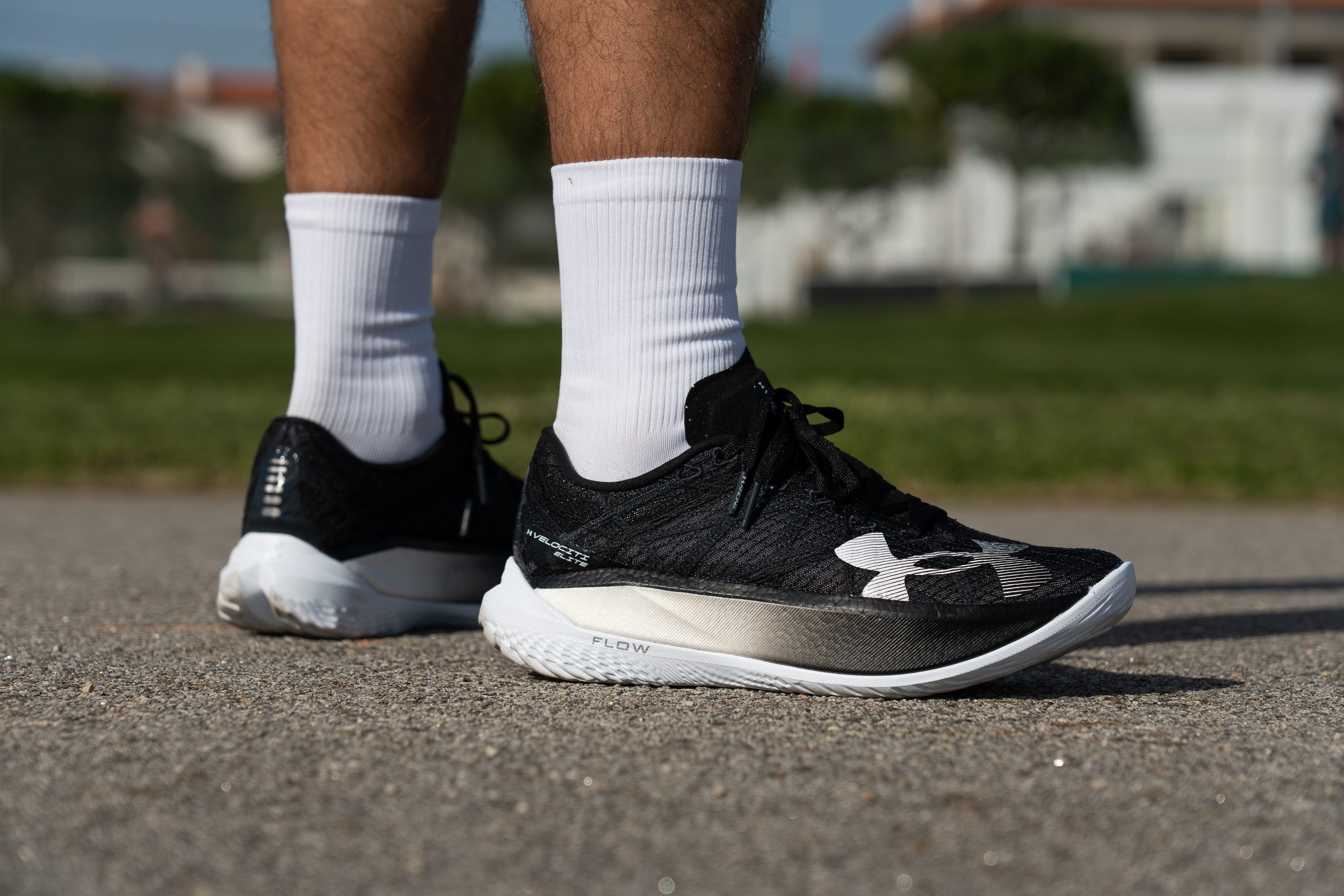
Who should NOT buy
The biggest issue with the Velociti Elite 2 is its excessive weight—tipping the scales at 9.07 oz (257g). That’s far beyond what we expect from a modern supershoe. For comparison, the ASICS Metaspeed Sky Paris and Nike Vaporfly 3 come in under 7 oz while delivering superior performance at a similar price point.
We also believe the midsole setup falls short of true supershoe standards. While it features a responsive Pebax layer, the lower portion is a EVA, significantly limiting energy return. If you're looking for race-day efficiency, we suggest the Saucony Endorphin Pro 4, which costs less yet features a full superfoam midsole. For those willing to invest a bit more, the Nike Alphafly 3 has already proven itself by breaking multiple world records.
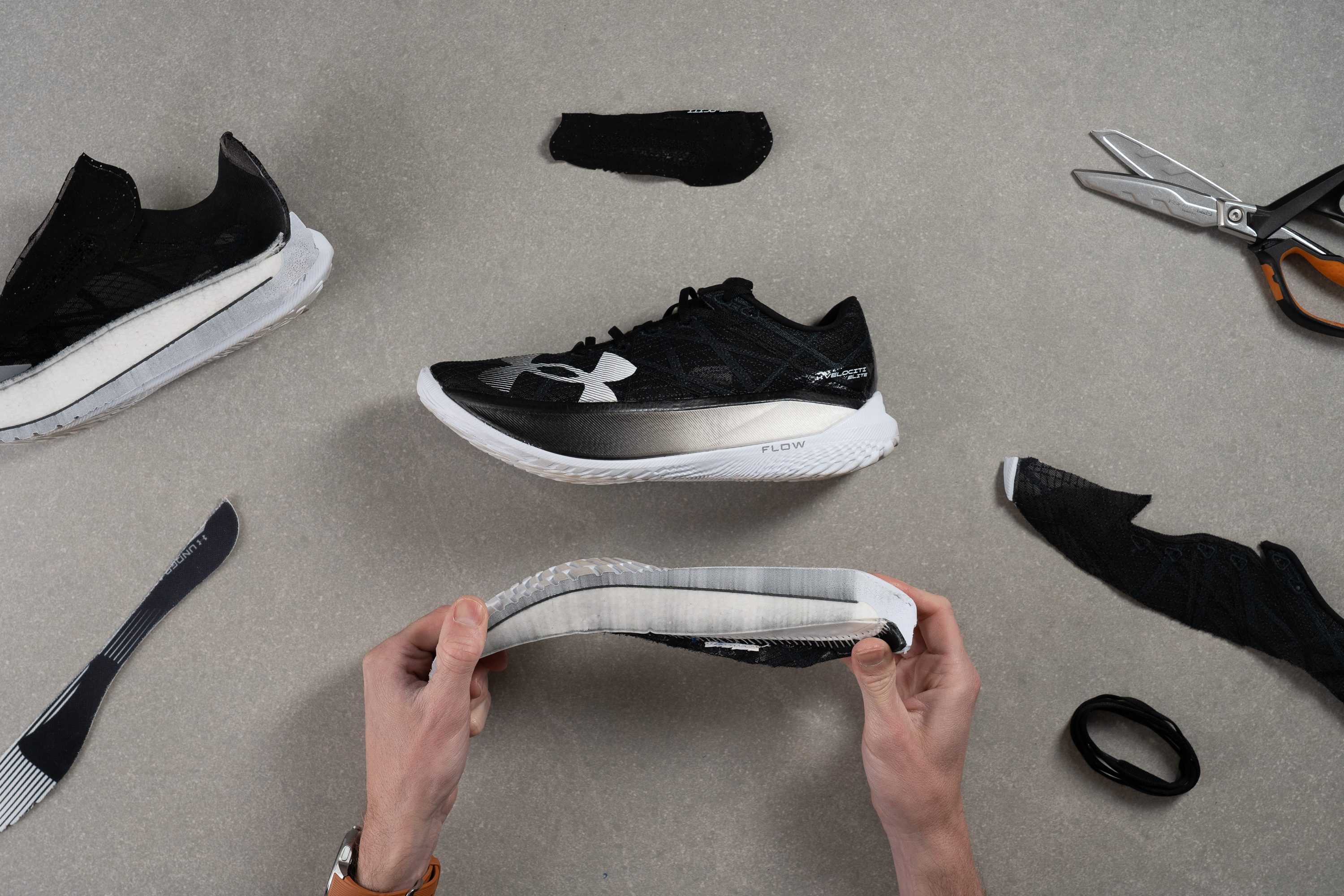
Amortiguación
Shock absorption
Using the ASTM F1976 standard, we measured the cushioning of the Velociti Elite 2 and found impressive results: 133 SA in the heel and 119 SA in the forefoot. That’s serious impact protection for any race-day effort!
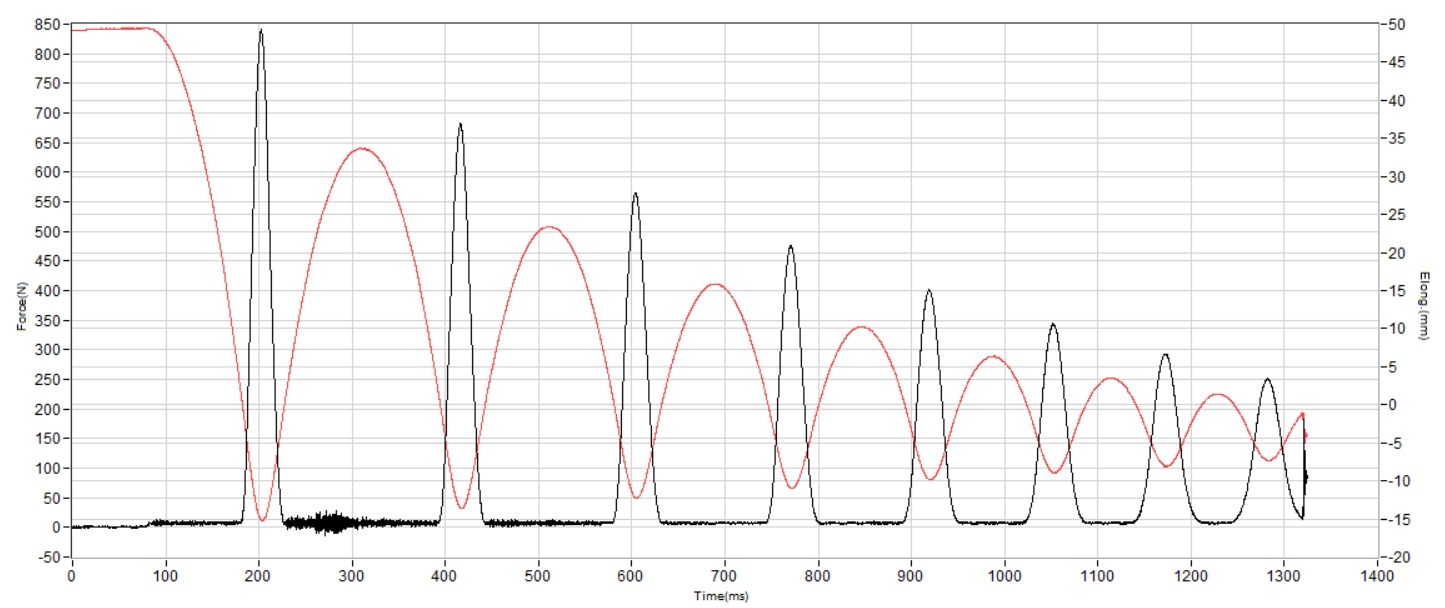
| Velociti Elite 2 | 133 SA |
| Media | 129 SA |
Energy return
It’s been a long road for Under Armour to catch up with the best supershoes out there, but they’ve finally arrived. While there’s still room for tweaks, they nailed the most crucial part: energy return.
We measured 72.3% in the heel and 73.3% in the forefoot, both impressive numbers.
| Velociti Elite 2 | 72.3% |
| Media | 58.6% |
Altura de la suela en la zona del talón
Every supershoe hitting the market needs to stay near the 40 mm limit but remain under it to comply with World Athletics regulations. We found that the Velociti Elite 2 comes in at 37.9 mm in the heel—race-day legal and packed with marathon-ready cushioning, exactly what we were looking for!
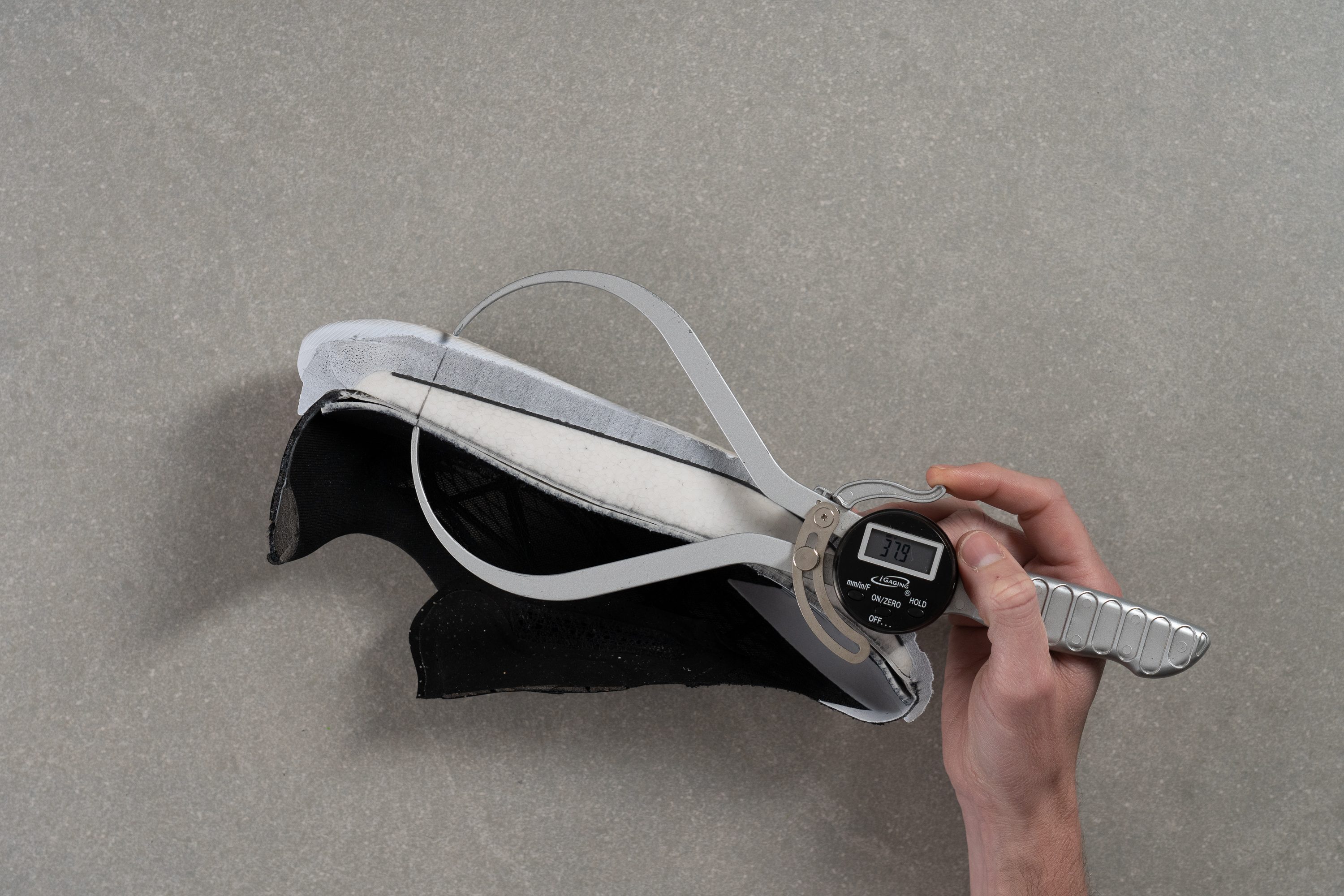
| Velociti Elite 2 | 37.9 mm |
| Media | 34.8 mm |
Altura de la suela en el antepié
The forefoot also offers plenty of cushioning at 31.9 mm, and here, the dual-foam setup of the Velociti Elite 2 becomes evident too. The white foam is Pebax—exactly what you want in a performance shoe—dominating the forefoot for a more propulsive feel, while the gray layer is Under Armour's Flow.
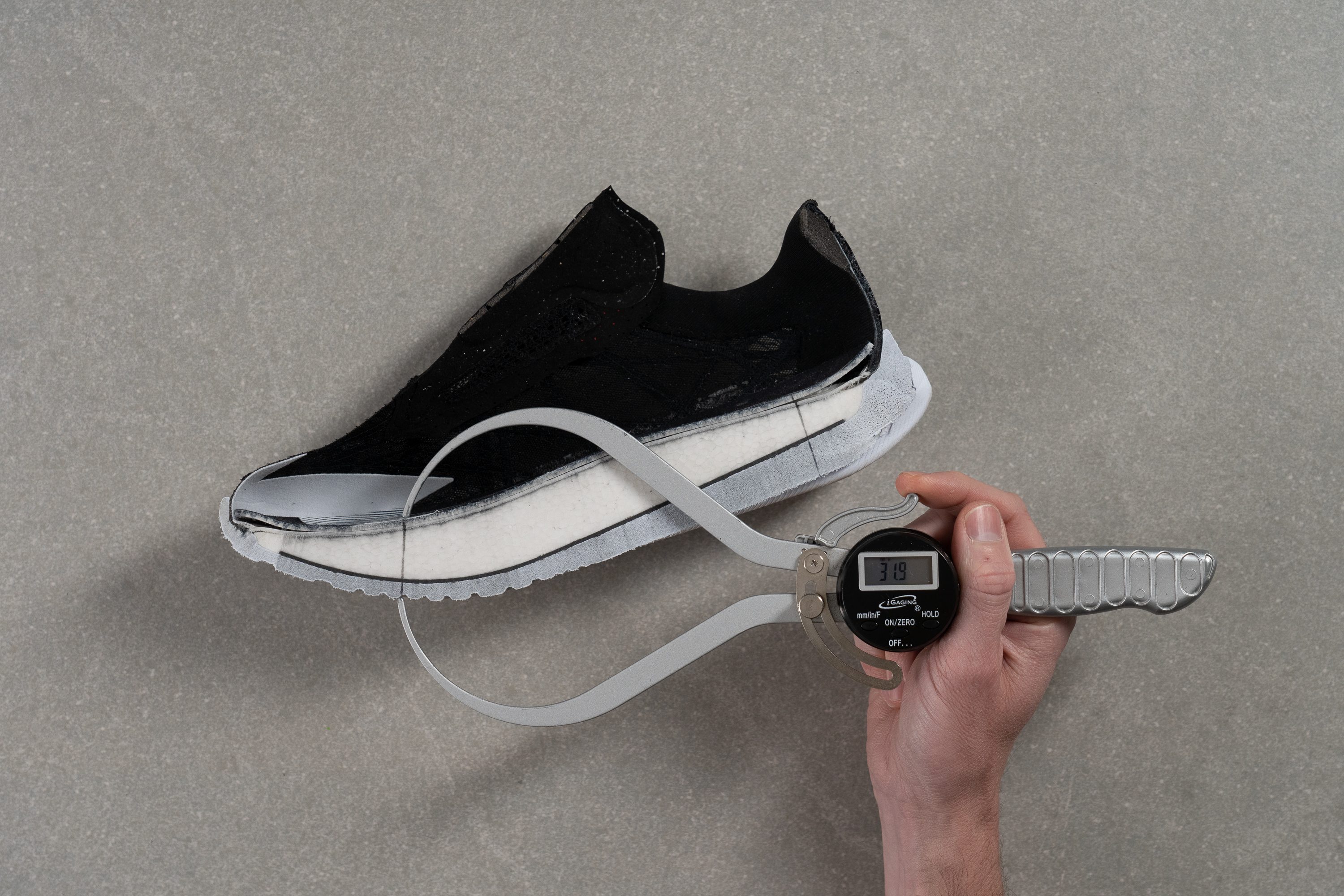
| Velociti Elite 2 | 31.9 mm |
| Media | 26.1 mm |
Drop
This leaves us with a 6-mm heel-to-toe drop—ideal for midfoot strikers yet adaptable for others.
However, it's worth noting that Under Armour lists the forefoot stack at 37.5 mm with a 2-mm drop, which doesn’t align with our measurements at all. In fact, in our experience, the Velociti Elite 2 doesn’t feel remotely like a near-flat shoe. But who knows where Under Armour measured the drop... certainly not at the World Athletics reference points.
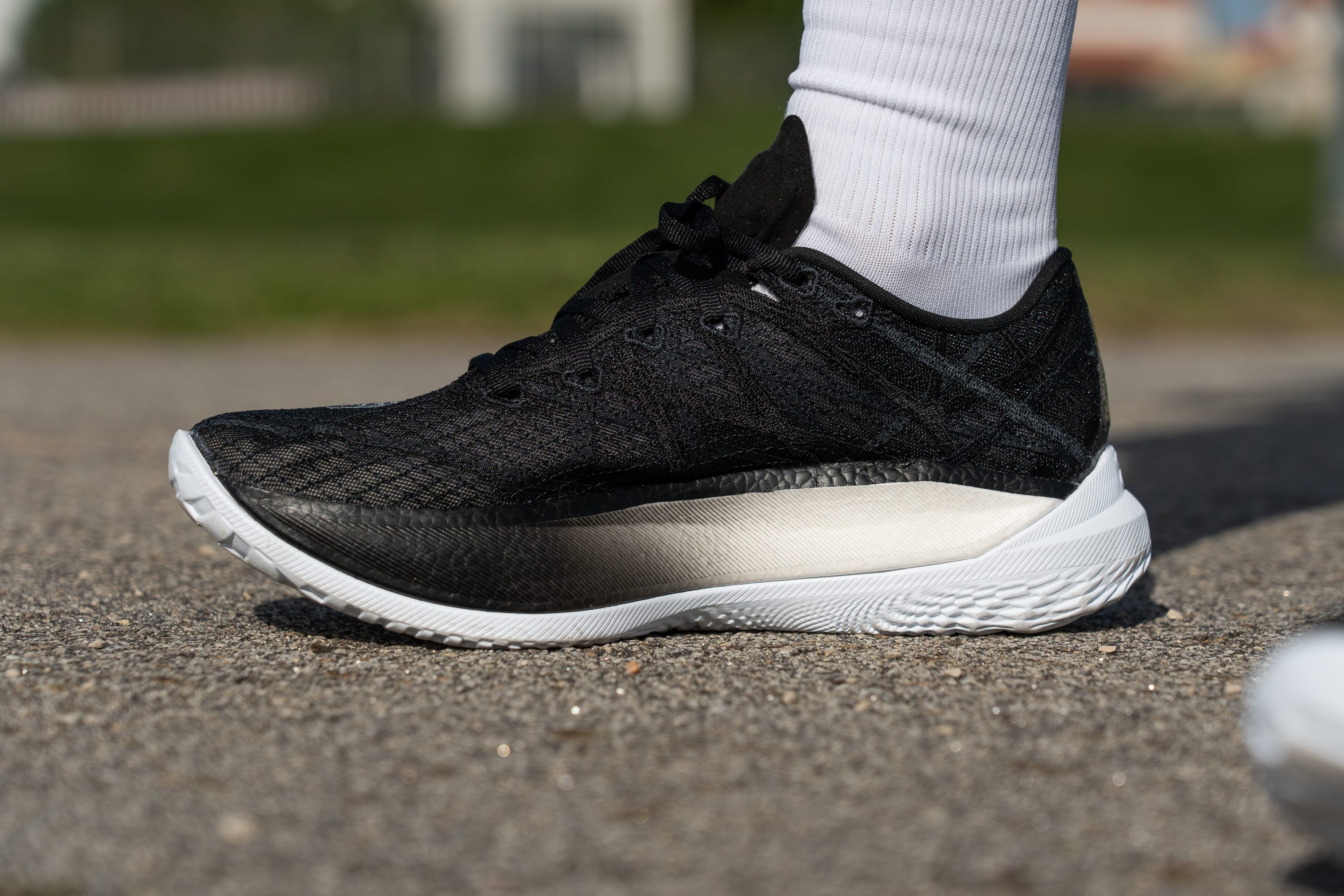
| Velociti Elite 2 | 6.0 mm |
| Media | 8.6 mm |
Suavidad de la mediasuela
Now, let's dive into the midsole—one of the two major dealbreakers for us. At the time of this shoe’s release, every top-tier supershoe in the Velociti Elite 2’s price range featured a full-PEBA foam (or comparable high-energy foam like TPEE or A-TPU) to ensure exceptional responsiveness.
However, that’s not the case here. Instead, this shoe uses a dual Pebax+EVA configuration. That said, let’s focus on the bright side for now—the primary foam is a super-bouncy material, prominently placed in the forefoot and midfoot, offering moderate softness at 21.5 HA.
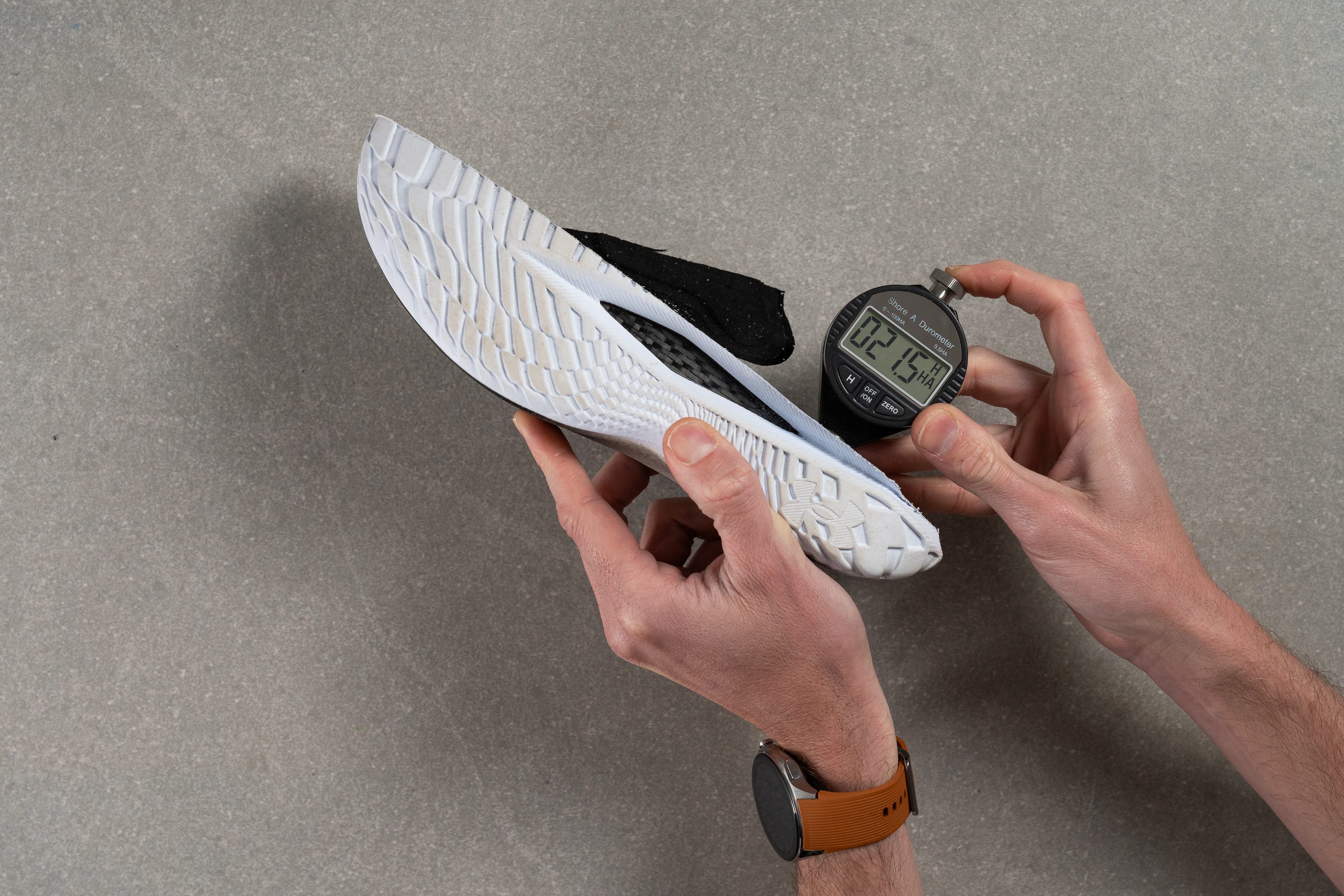
| Velociti Elite 2 | 21.5 HA |
| Media | 20.4 HA |
Suavidad de la espuma secundaria
As we hinted earlier, the secondary foam is a firm EVA with a durometer reading of 23.0 HA—lacking the energetic rebound expected in a top-tier racer, falling short in both responsiveness and performance.
In fact, we can't call the Velociti Elite 2 a supershoe. It flirts with the category, but its dual-foam setup with a layer of EVA keeps it from fully reaching that real elite status. It’s close, but not quite there.
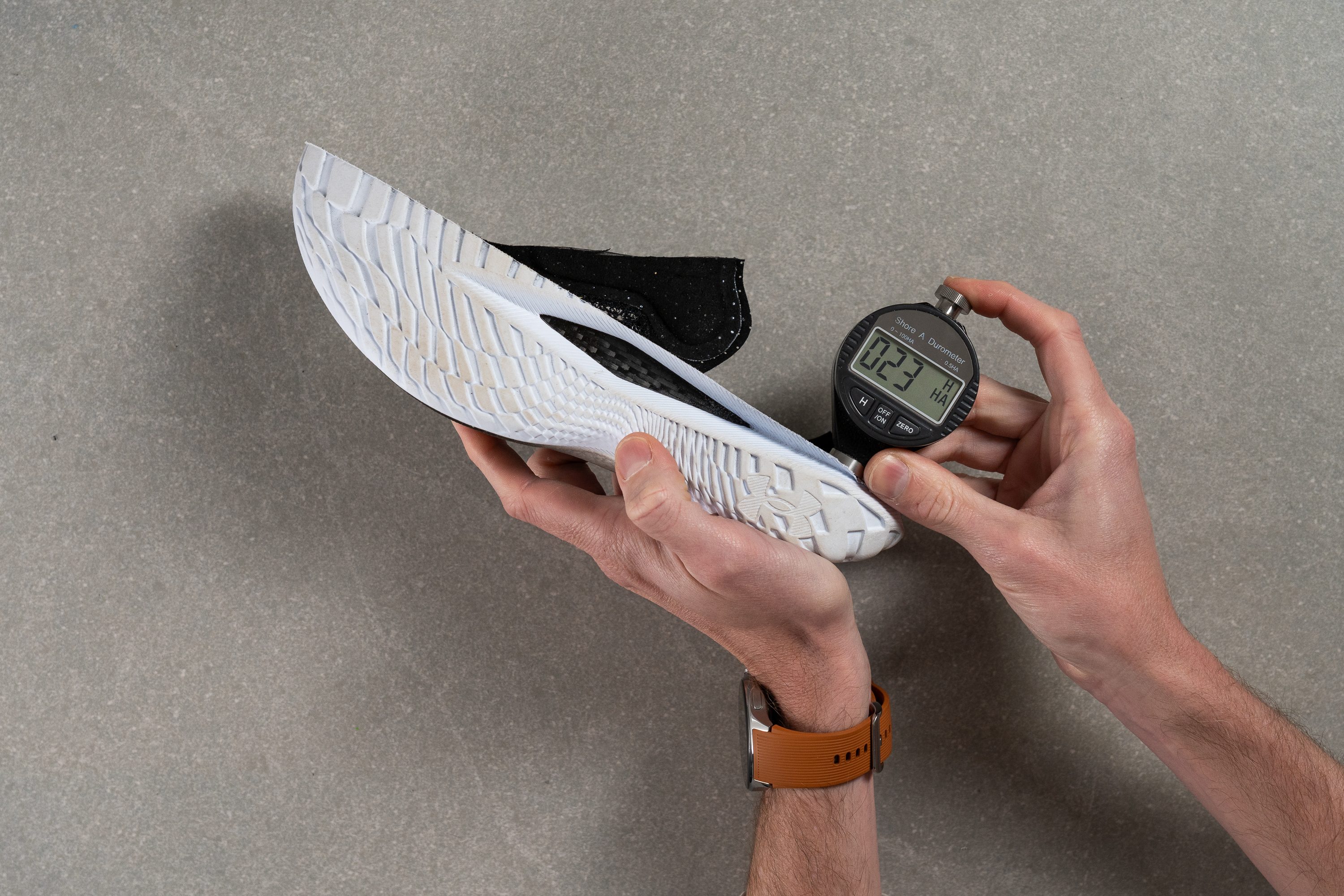
| Velociti Elite 2 | 23.0 HA |
| Media | 22.6 HA |
Rocker
For runners looking for a racing shoe with a pronounced late-stage rocker, the Velociti Elite 2 delivers—once again confirming that it’s best suited for midfoot and forefoot strikers.
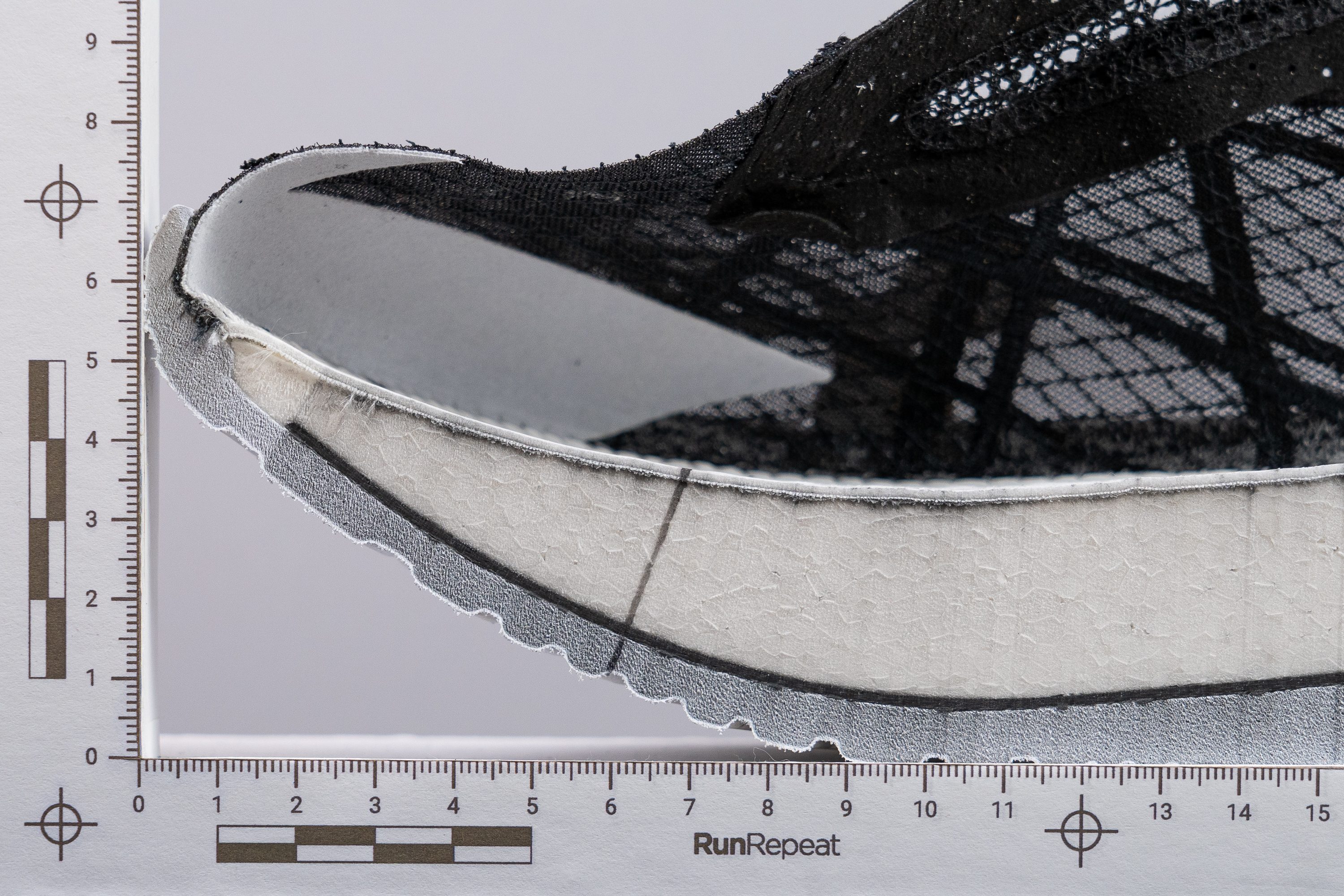
Plate
The supershoe formula demands a carbon plate sandwiched between two foam layers, and the Velociti Elite 2 follows this blueprint. But, as we detailed earlier, it falters with the secondary, firm EVA foam.
Our cross-section provides a crystal-clear breakdown of the foam distribution and plate shape, revealing how much Pebax (white) and EVA (grey) exist at each point—something impossible to determine from the exterior.
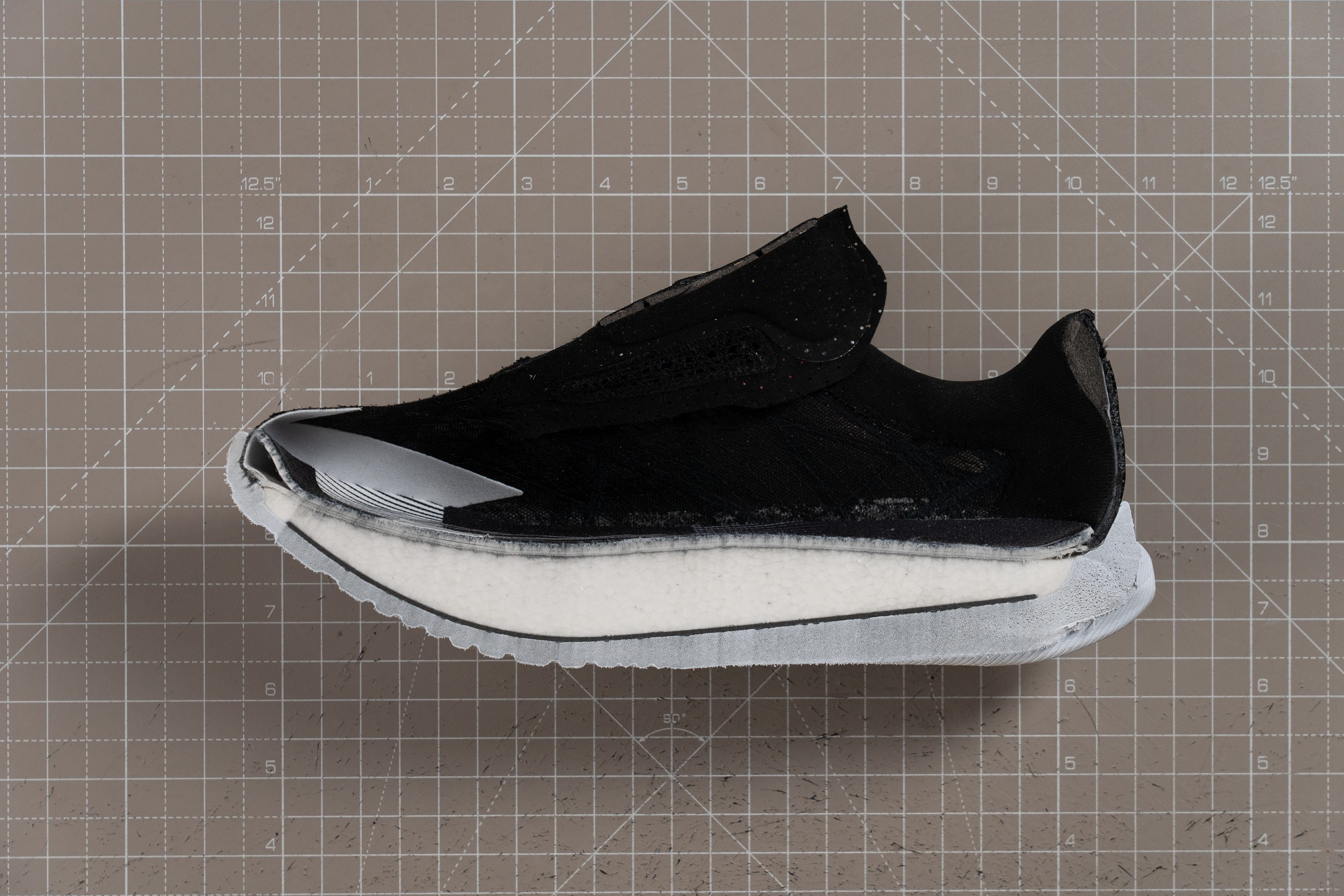
Tallaje y ajuste
Talla
Las Under Armour Velociti Elite 2 tallan bien (17 votos).
Anchura / Ajuste
Under Armour typically designs narrow-fitting shoes, so we were genuinely surprised when we first slipped these on. They felt noticeably roomier than anticipated for a racing shoe.
After testing with our precise gel mold method, we measured 94.9 mm at the widest point. While this isn’t exceptionally wide across all running shoes, it’s undeniably more accommodating compared to most supershoes, making it a rare-but-welcome exception in this category.
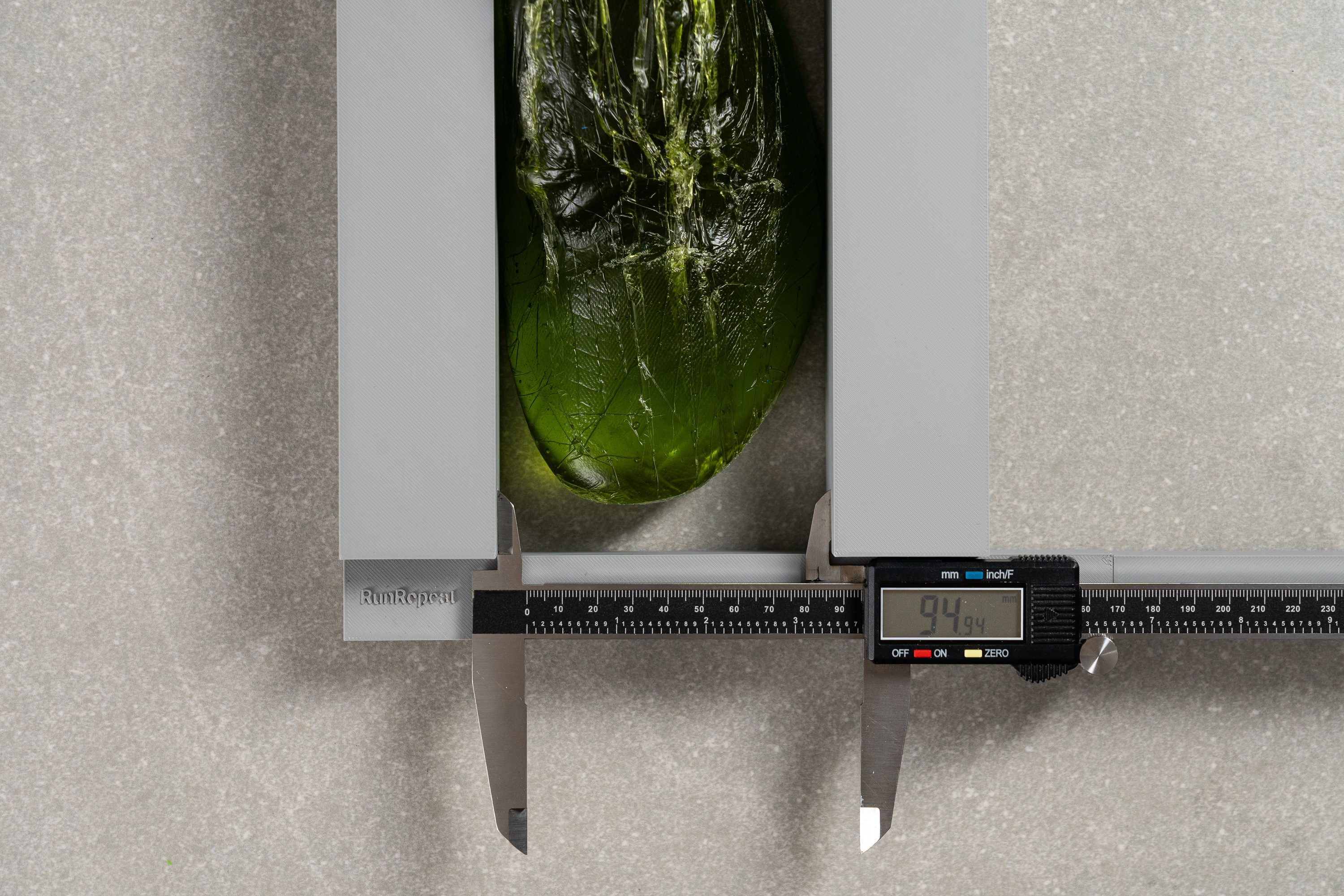
| Velociti Elite 2 | 94.9 mm |
| Media | 95.1 mm |
Anchura de la parte delantera
We took a second measurement at the big toe area, and it came in at 74.0 mm. According to our findings, this level of spaciousness is more in line with a daily trainer, making it a viable option for runners who find supershoes overly restrictive.
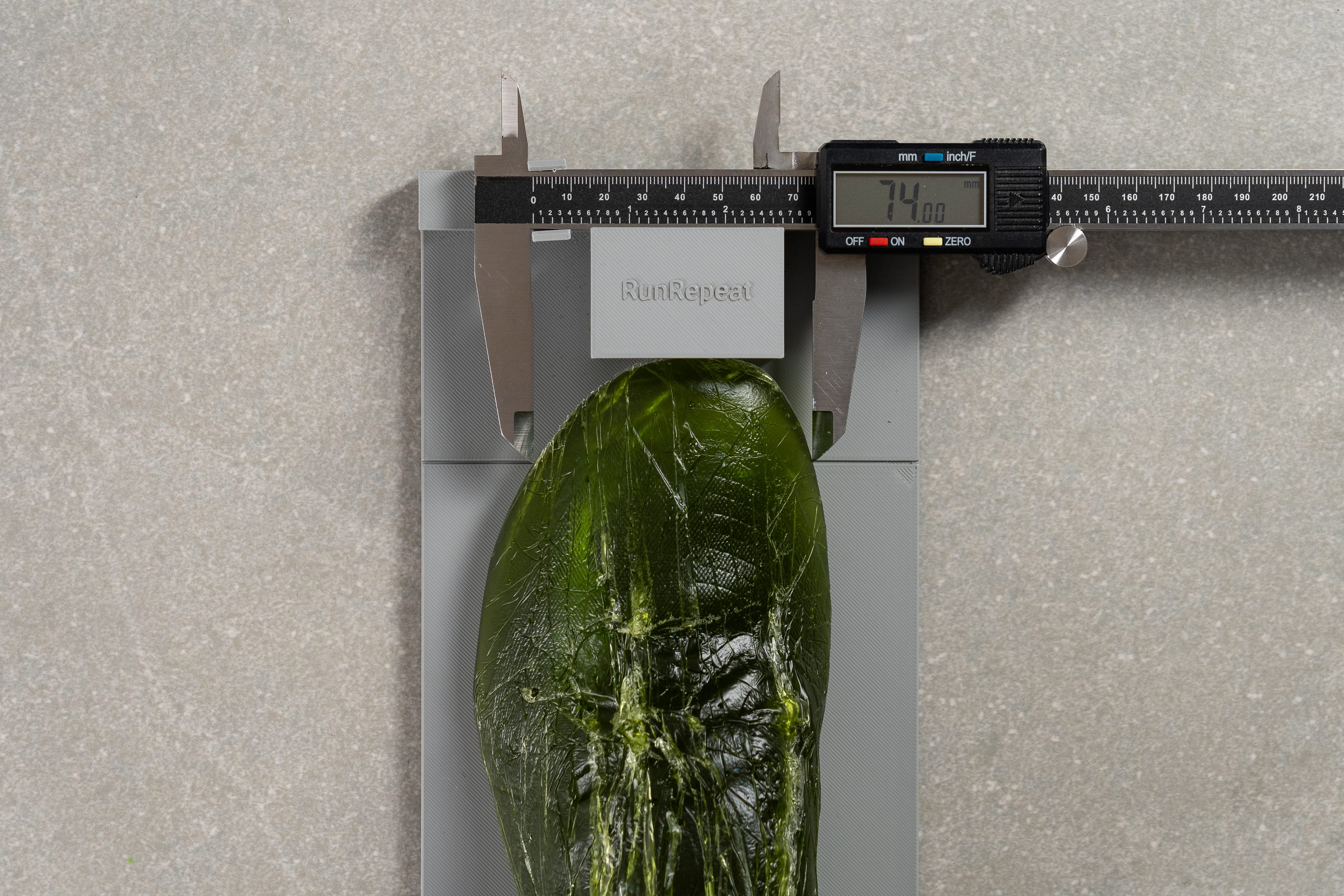
| Velociti Elite 2 | 74.0 mm |
| Media | 73.3 mm |
Altura de la parte delantera
Where it does feel noticeably tight is in height, as the toebox volume is kept low to ensure a race-ready, locked-in fit.
This didn’t surprise us—racing shoes often sacrifice vertical space to enhance security. However, those expecting an equally spacious feel based on previous width measurements might find the low-profile design a bit disappointing.
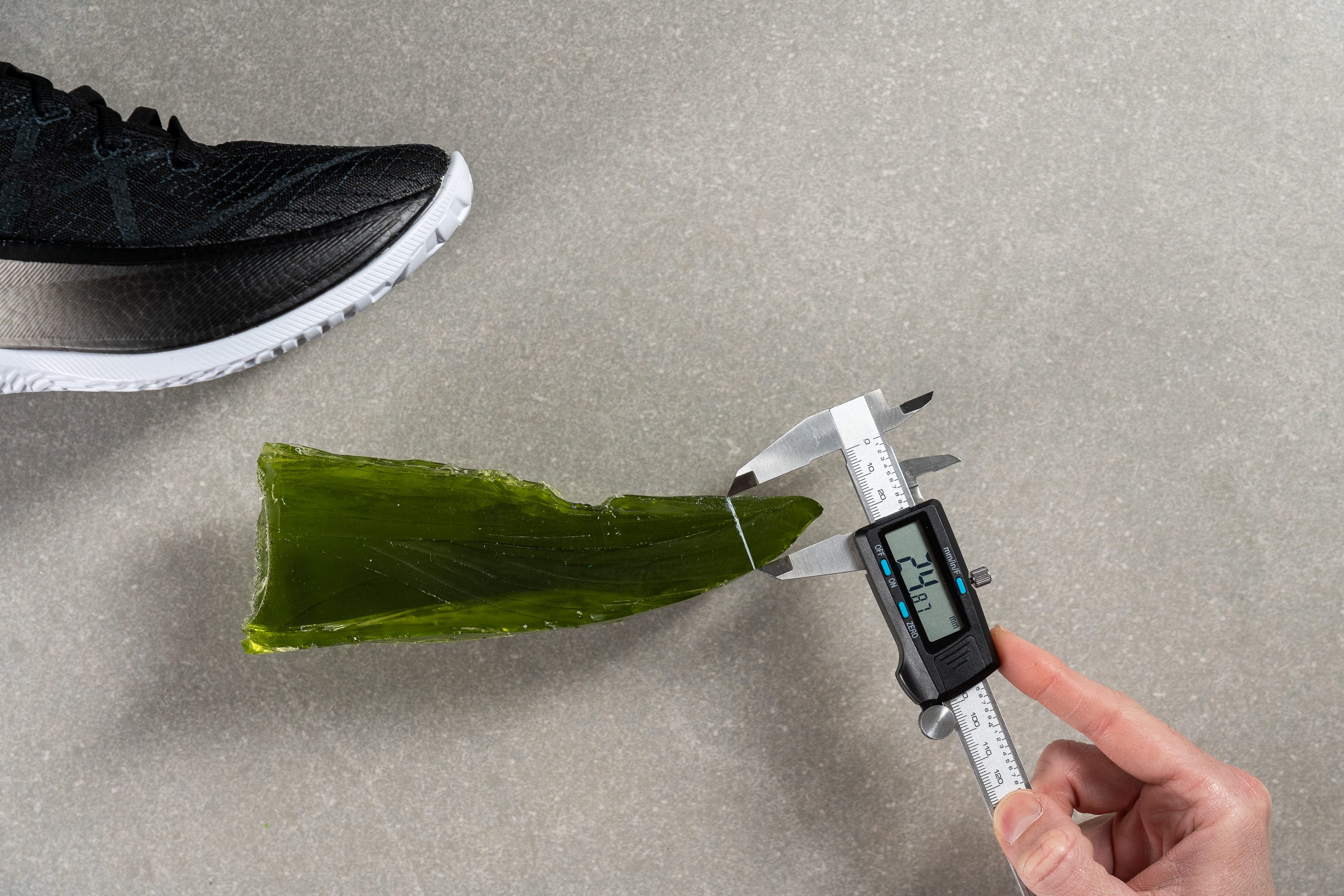
| Velociti Elite 2 | 24.9 mm |
| Media | 27.1 mm |
Tracción / Agarre
Traction test
The Velociti Elite 2 delivers confident grip underfoot. Hitting a 0.47 in our lab test is no small feat—this makes it a rain-ready, race-day supershoe for runners aiming to push through wet or dry races.
| Velociti Elite 2 | 0.47 |
| Media | 0.48 |
Diseño de la suela exterior
Under Armour’s FLOW system replaces traditional rubber with a rubberized EVA midsole that also acts as the outsole. While this material provides outstanding grip, it’s likely to wear down quickly than harder rubber compounds.
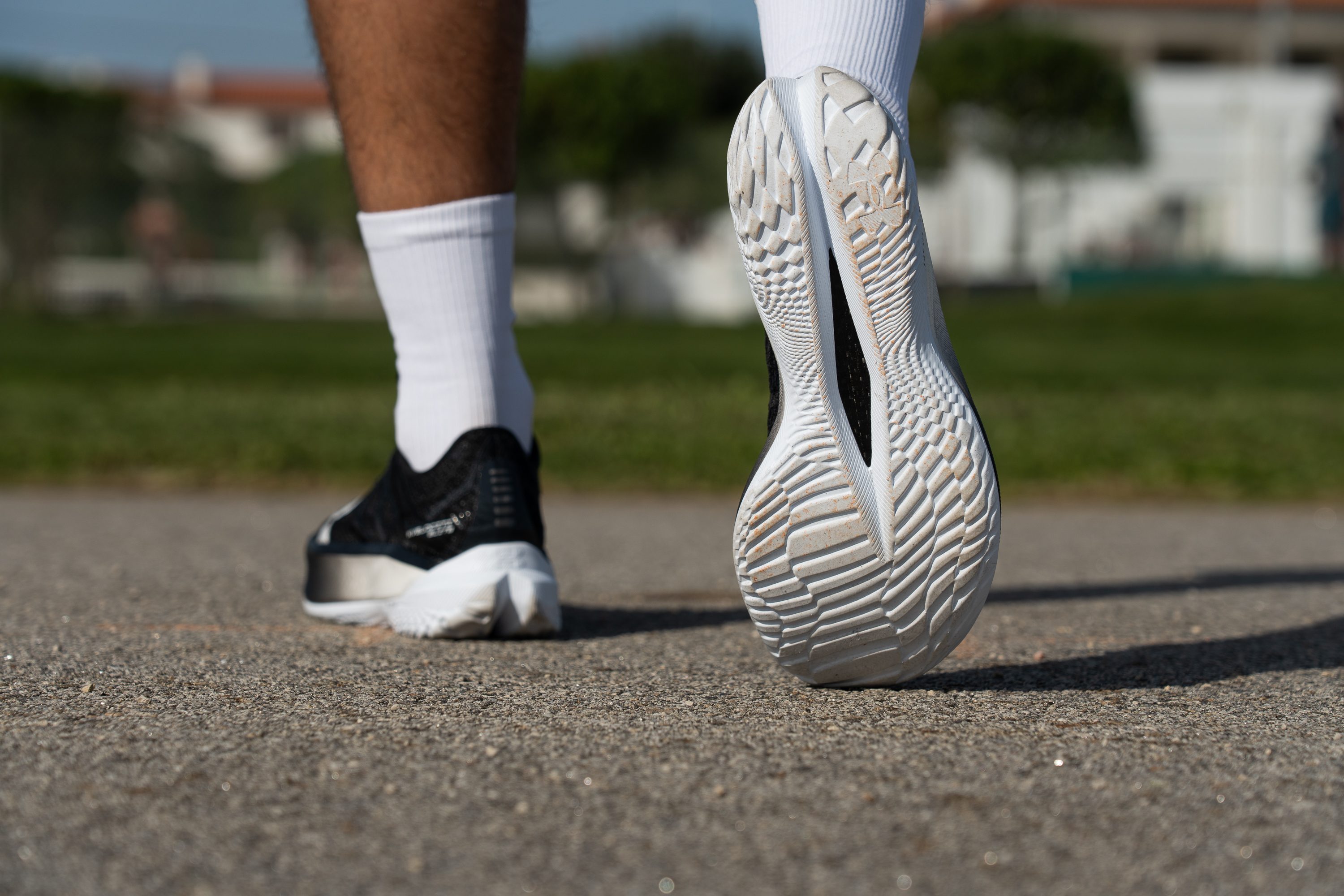
Flexibilidad / Rigidez
The carbon plate embedded in this midsole is quite stiff. In our 30-degree bend test, it registered a high result of 19.8N.
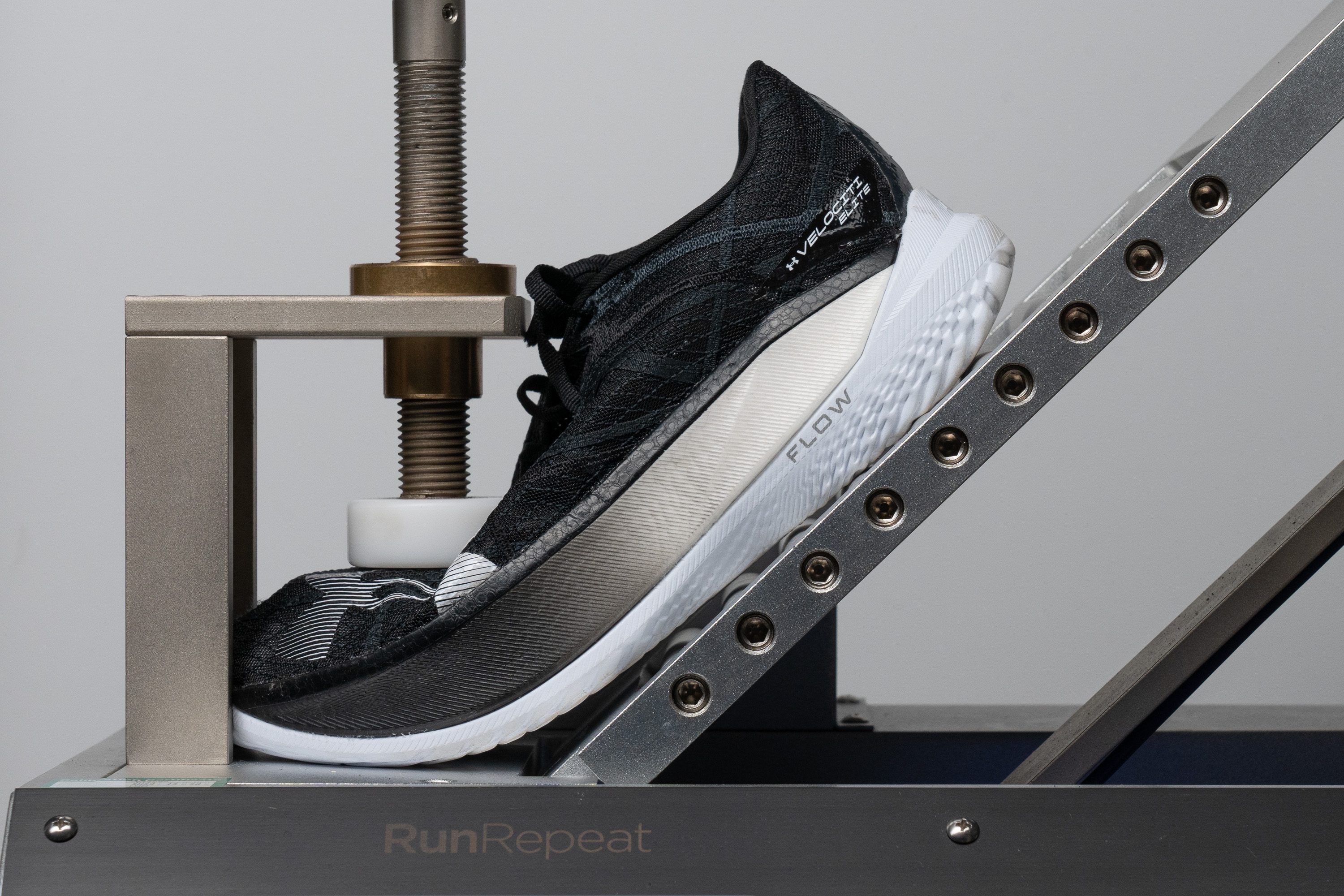
| Velociti Elite 2 | 19.8N |
| Media | 15.2N |
Peso
This shoe has two major drawbacks. One is the dense-and-dull EVA foam sitting beneath the carbon plate. The other is its excessive weight—at 9.07 oz (257g), it’s among the heaviest racing shoes we’ve tested.
| Velociti Elite 2 | 9.1 oz (257g) |
| Media | 9.3 oz (265g) |
Transpirabilidad
While the Velociti Elite 2 may be heavy and not the bounciest, it excels in other areas—especially breathability. In our lab tests, it earned a flawless 5/5, making it one of the most well-ventilated supershoes we've tested. Maybe Under Armour should have named it the Airflow Elite 2?
The upper immediately impressed us, and once we moved it over a bright light, it was clear just how much ventilation it provides. We also appreciated the thoughtful midfoot design, where Under Armour strategically placed lightweight reinforcements to enhance structure without compromising airflow.
Under the microscope, the engineered mesh looked absolutely mesmerizing.
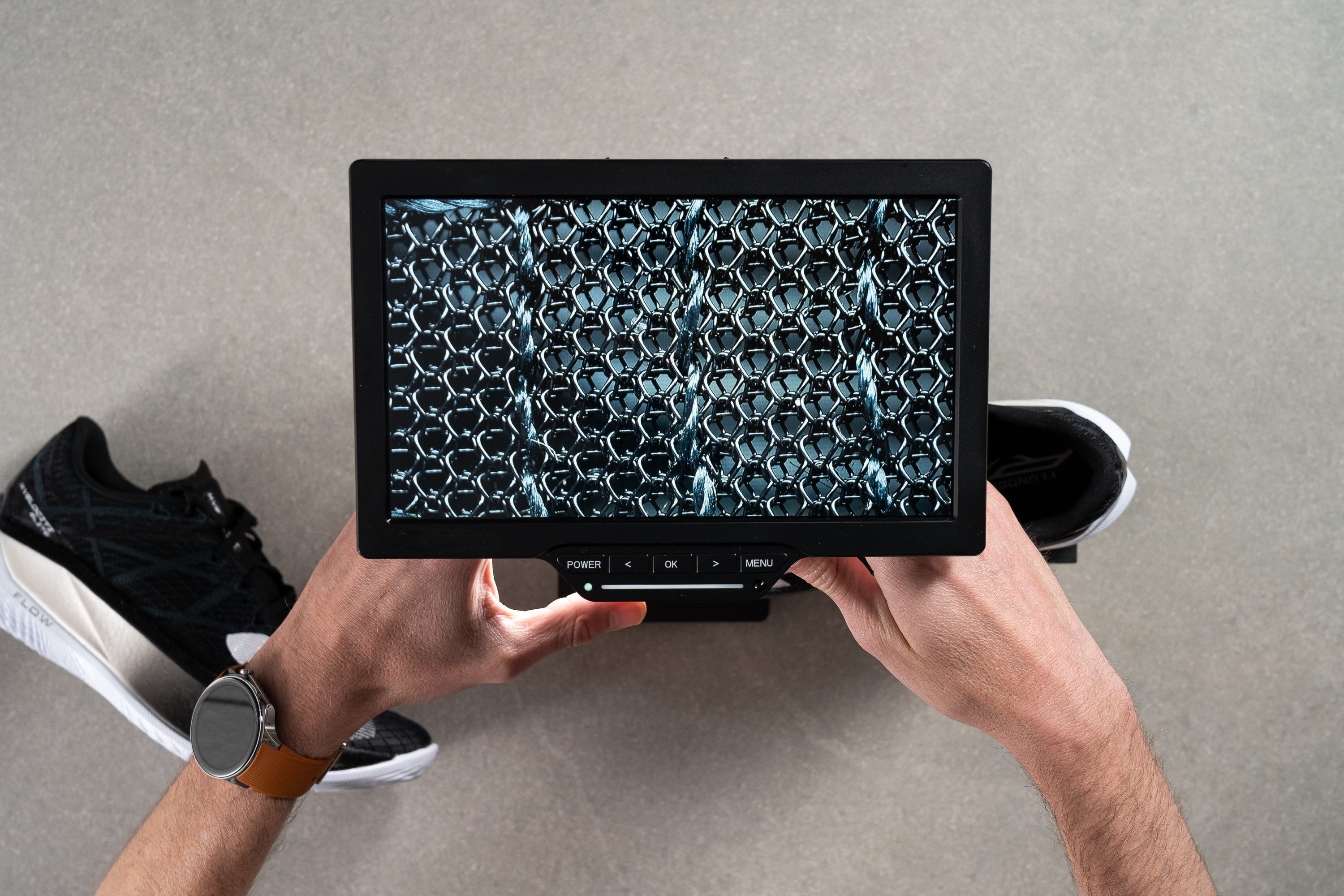
In fact, we believe that this upper it’s undoubtedly on par with the shoe’s premium price tag.
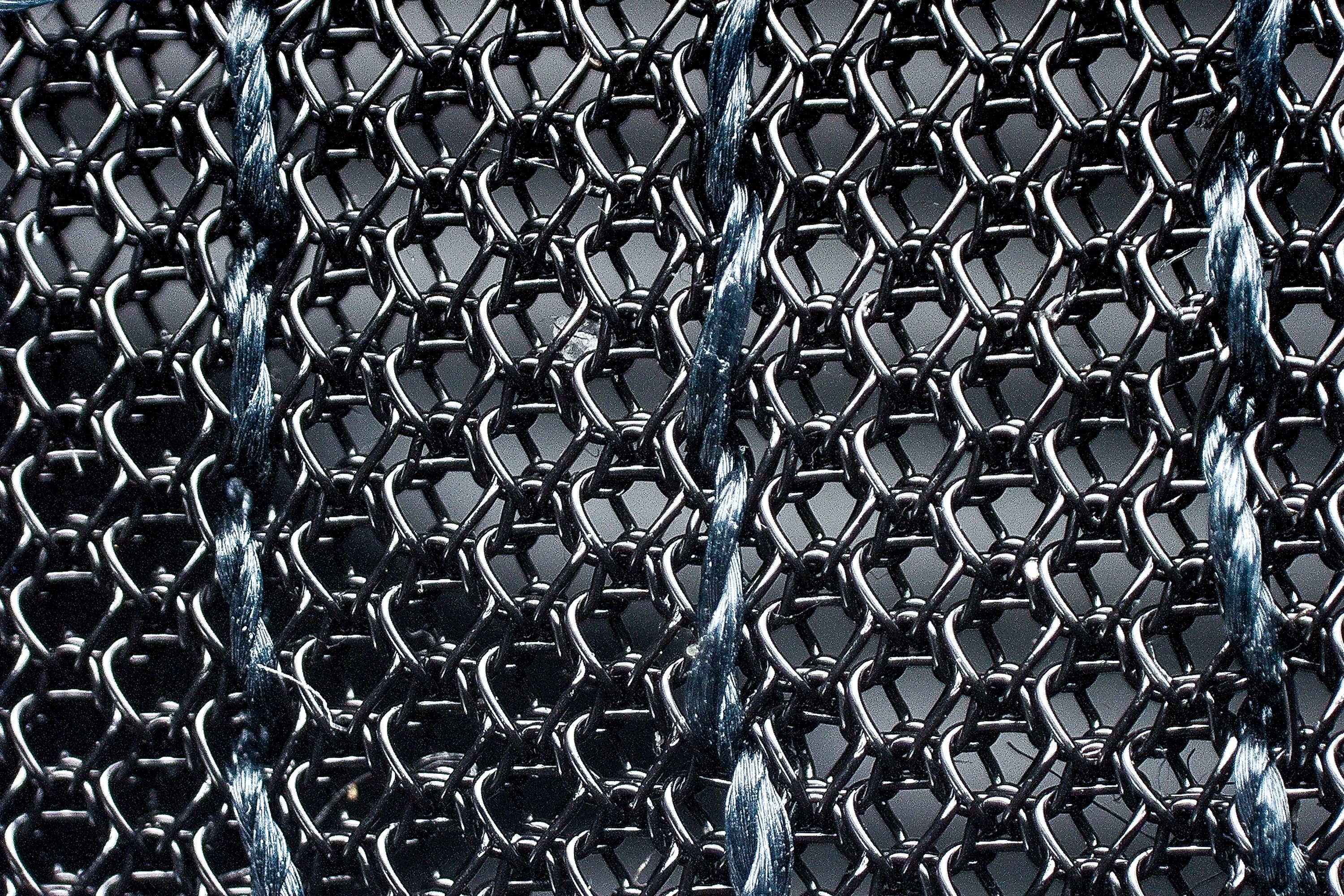
Despite being razor-thin, the upper still offers noticeable padding in key areas. The tongue and heel collar contain more cushioning than many competitors, ensuring a comfortable fit but likely contributing to the shoe’s higher weight.
Overall, we think Under Armour nailed the upper design, combining an airy, race-ready build with well-placed support elements. If only the rest of the shoe had followed the same blueprint...
| Velociti Elite 2 | 5 |
| Media | 3.7 |
Estabilidad
Prueba de estabilidad lateral
Whether made for a blistering-fast 5K or a full marathon, racing shoes are rarely stable—they're built purely for speed.
The Velociti Elite 2 follows this pattern, though stability depends heavily on footstrike. In our experience, heel strikers will find it wildly unstable, with noticeable wobbling on landings. However, midfoot and forefoot strikers will benefit from its geometry, which provides a somewhat steady ride despite its height.
Rigidez torsional
We fully expected a 5/5 result in this test, as is almost always the case with carbon-plated shoes—and the Velociti Elite 2 delivered exactly that, with no surprises.
| Velociti Elite 2 | 5 |
| Media | 3.5 |
Rigidez del contrafuerte del talón
The heel counter looks average at first glance, but don’t be fooled—it offers virtually no resistance when pressed. It bent effortlessly in our test, scoring a 1/5, meaning there’s little to no support in this area.
| Velociti Elite 2 | 1 |
| Media | 2.9 |
Anchura de la mediasuela - antepié
The shoe’s midsole looks incredibly aggressive, yet the forefoot measures a fairly standard 114.5 mm. This led us to suspect that the real story lies in the heel.
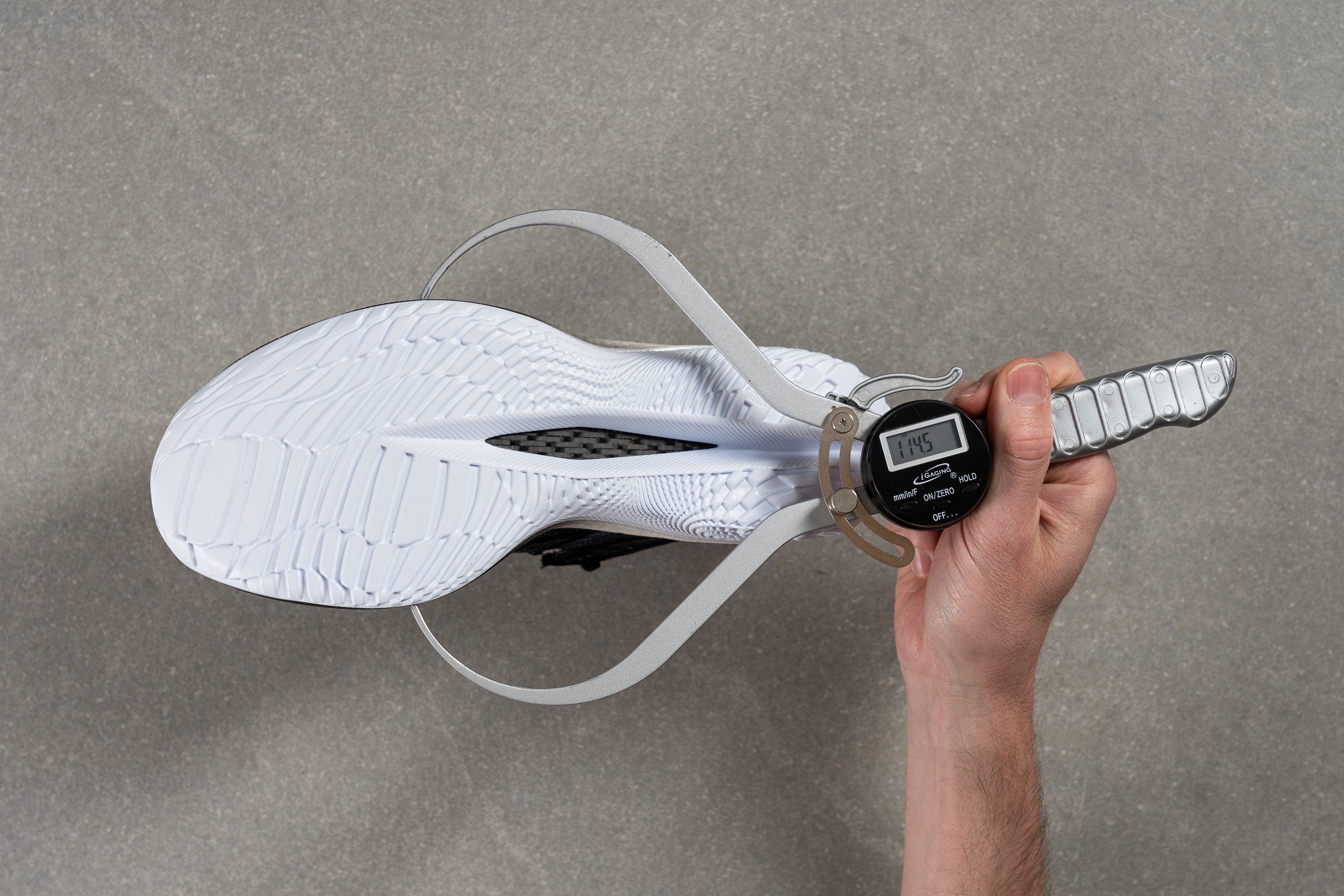
| Velociti Elite 2 | 114.5 mm |
| Media | 114.3 mm |
Anchura de la mediasuela - talón
And here it is—the heel on this shoe is downright extreme!
This is another clear reason why we simply can’t recommend it for rearfoot strikers. At just 73.5 mm, it ranks among the narrowest we’ve ever measured in the lab.
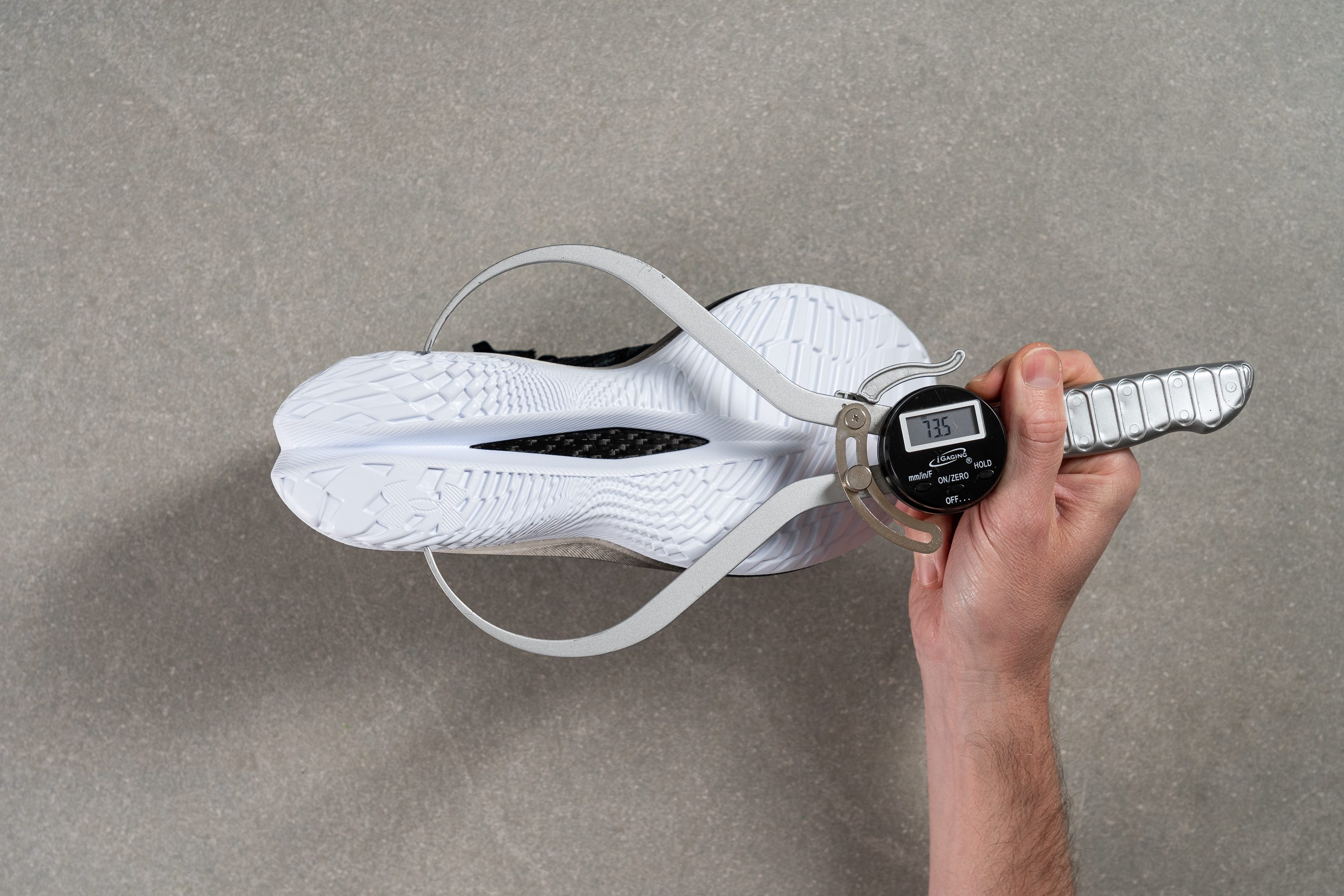
| Velociti Elite 2 | 73.5 mm |
| Media | 90.7 mm |
Durabilidad
Durabilidad de la parte delantera
Our first Dremel test delivered a surprisingly strong result, proving that the upper is the most impressive part of this shoe. Earning a 3/5 with such an ultra-thin material is a real feat.
| Velociti Elite 2 | 3 |
| Media | 2.6 |
Durabilidad del acolchado del talón
The heel padding proved less durable, scoring a lower 2/5 in our test. It’s not a major concern, but runners who tend to wear down this area quickly should keep an eye on it.
| Velociti Elite 2 | 2 |
| Media | 3.4 |
Durabilidad de la suela
As expected, the rubberized EVA outsole crumbled under our Dremel, showing 6.2 mm of total damage. While real-world wear may be less extreme, it’s clear this outsole won’t match the longevity of most other supershoes.
| Velociti Elite 2 | 6.2 mm |
| Media | 1.1 mm |
Varios
Grosor de la plantilla
A small but welcome touch that slightly compensates for the EVA foam is the TPE insole—a nice addition despite its minimal 2.0 mm thickness.
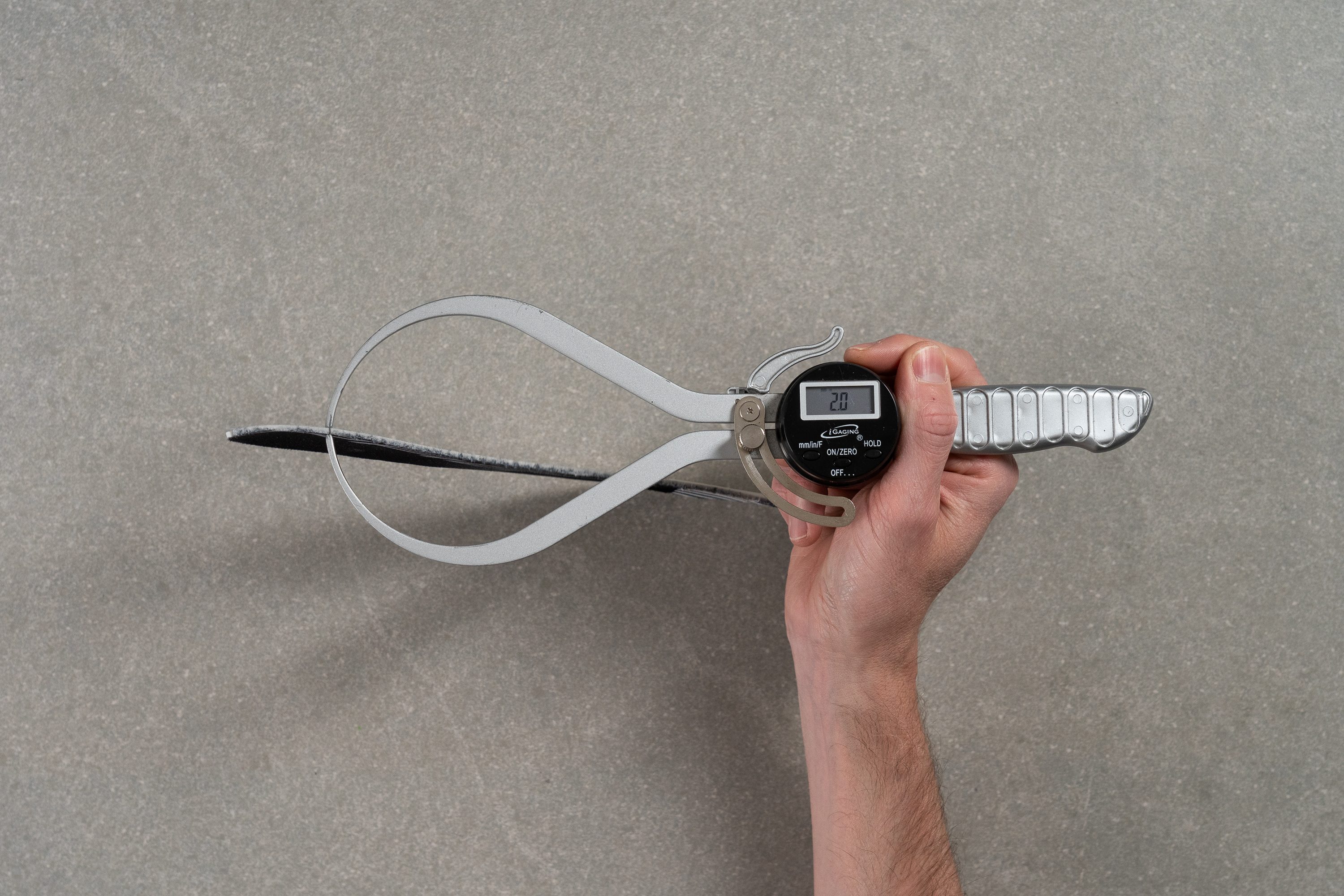
| Velociti Elite 2 | 2.0 mm |
| Media | 4.5 mm |
Plantilla extraíble
We removed the insole effortlessly—something not always possible in competition shoes. However, with the toebox’s low volume and the insole’s minimal thickness, finding a suitable replacement or using custom orthotics will be a real challenge.
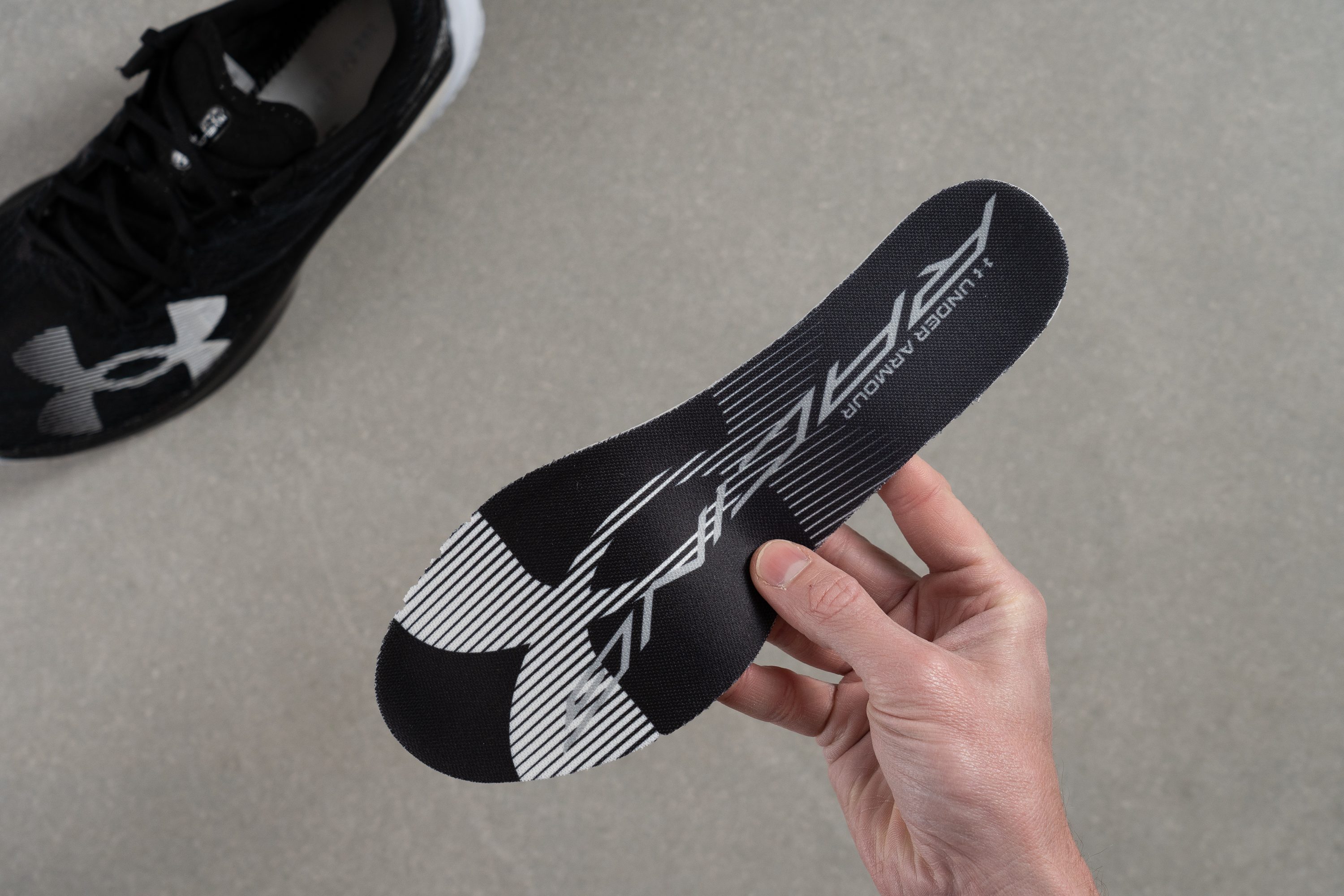
| Velociti Elite 2 | Sí |
Rigidez de la mediasuela en frío (%)
The midsole became only 9% firmer after 20 minutes in the freezer—a solid result for a shoe that already leans slightly on the firm side.
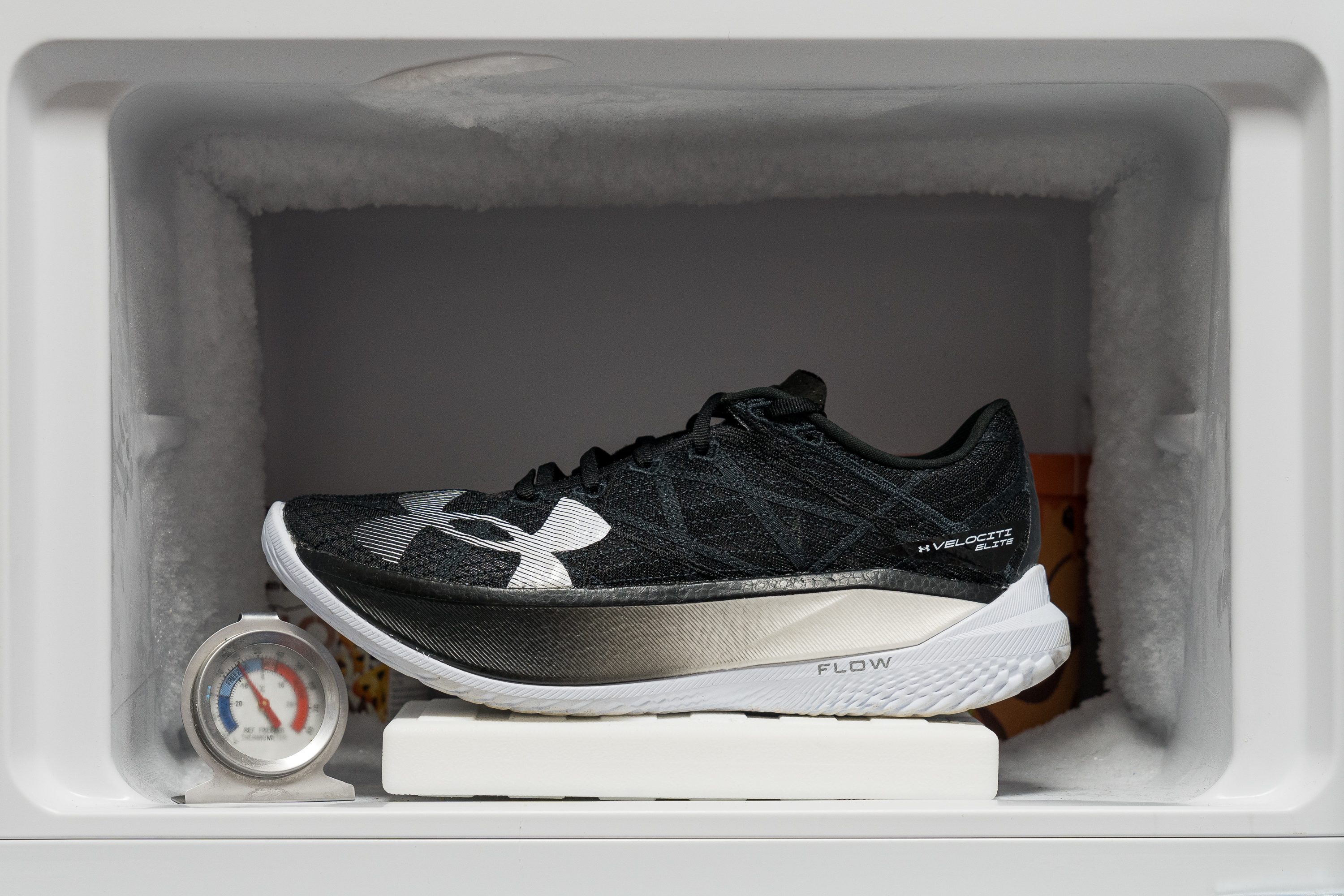
| Velociti Elite 2 | 9% |
| Media | 25% |
Elementos reflectantes
No reflective elements on the Velociti Elite 2—not surprising for a pure racing shoe.
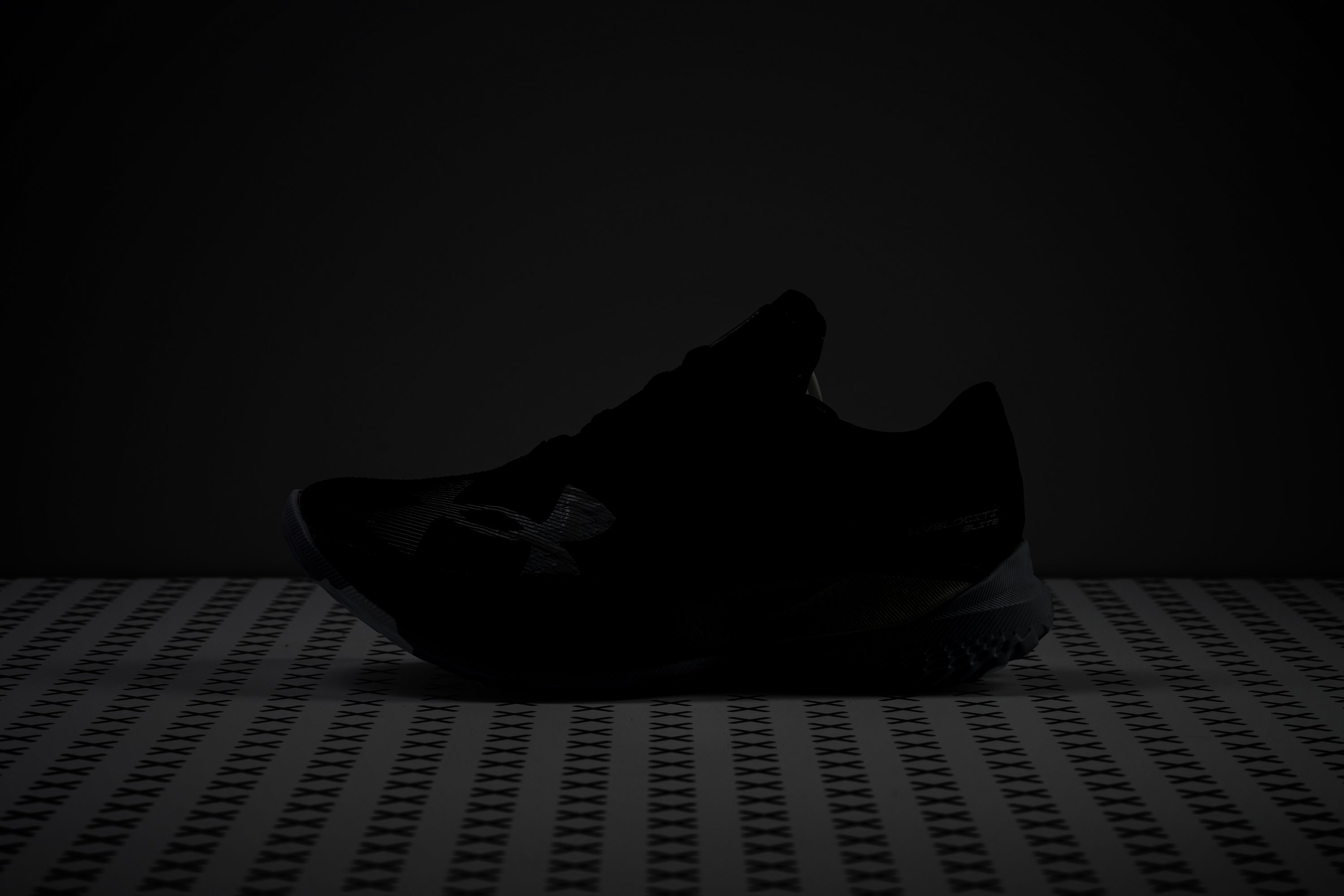
| Velociti Elite 2 | No |
Acolchado de la lengüeta
Under Armour occasionally takes bold risks with running shoe designs—just look at the SlipSpeed Mega—but with this one, they kept things pretty straightforward.
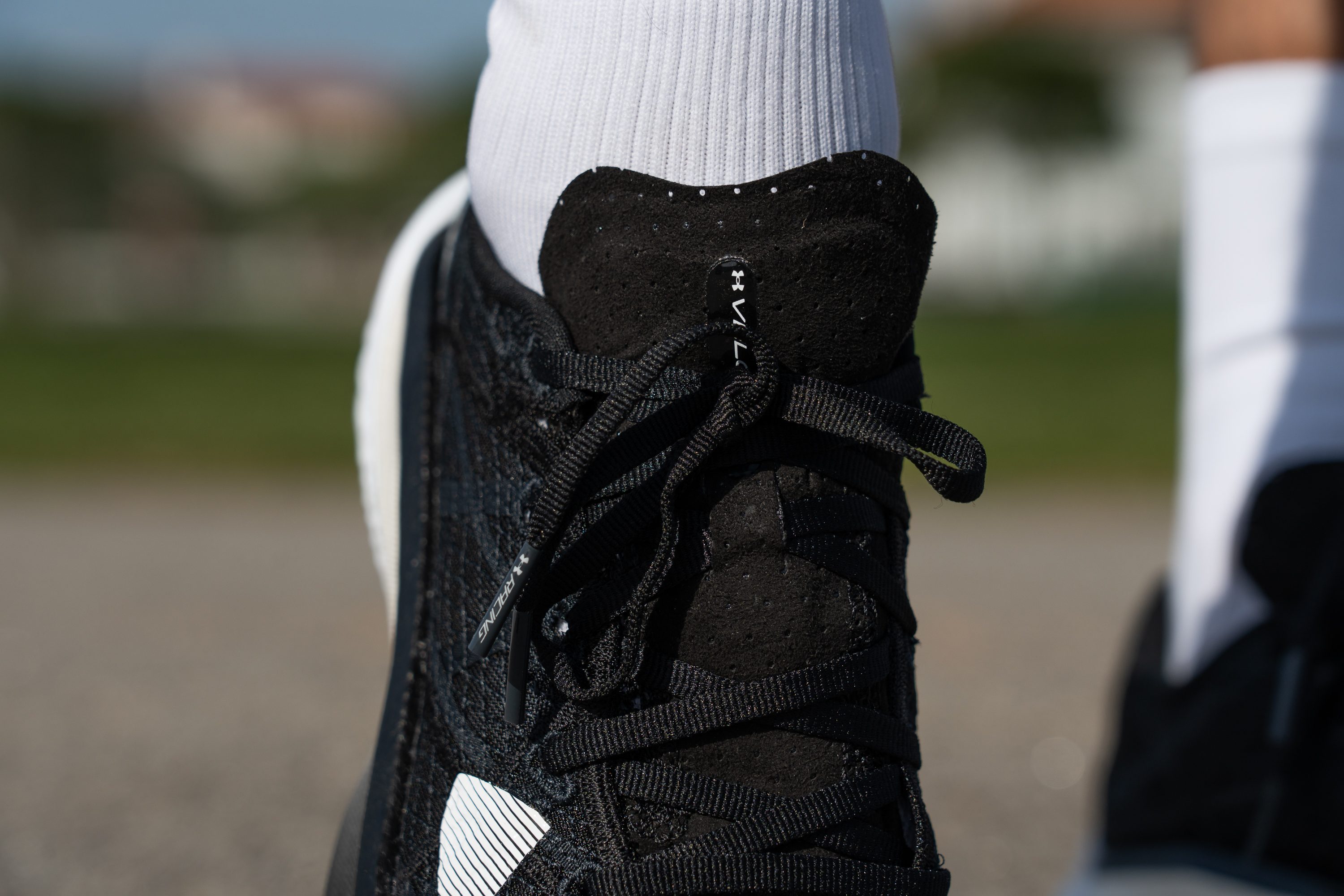
It features a well-padded, perforated tongue measuring 4.4 mm thick—generous for a performance shoe. In our experience, this makes it a solid choice for runners who occasionally struggle with instep discomfort during longer distances.
We also discovered a strategically-placed tongue loop, essential for preventing any mid-run shifting. On the downside, the laces felt cheap for a €280 shoe—definitely an area where Under Armour could have done better.
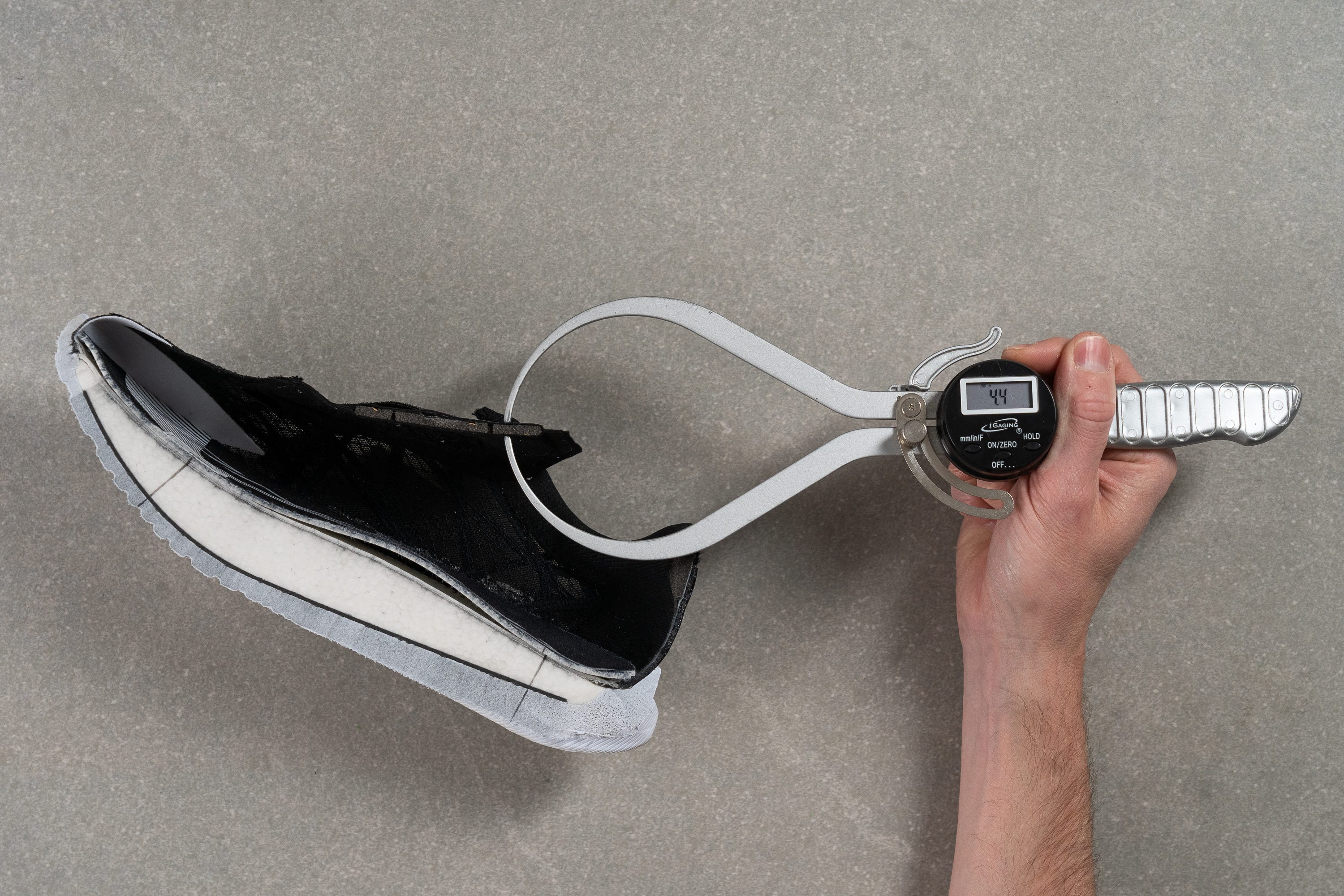
| Velociti Elite 2 | 4.4 mm |
| Media | 5.8 mm |
Lengüeta: tipo de refuerzo
The tongue isn’t fixed to the sides and moves freely—common in supershoes, yet still frustrating to deal with!

| Velociti Elite 2 | Ninguno |
Precio
The Velociti Elite 2 carries a premium price tag, but we believe it needs to deliver more to justify the cost. At around €220, it could be a solid choice—but at its current price, it can't compete with world-record-setting supershoes.
| Velociti Elite 2 | $250 |
Tirador del talón
This shoe is already too heavy for a racer, so adding extra grams with a heel tab feels unnecessary.
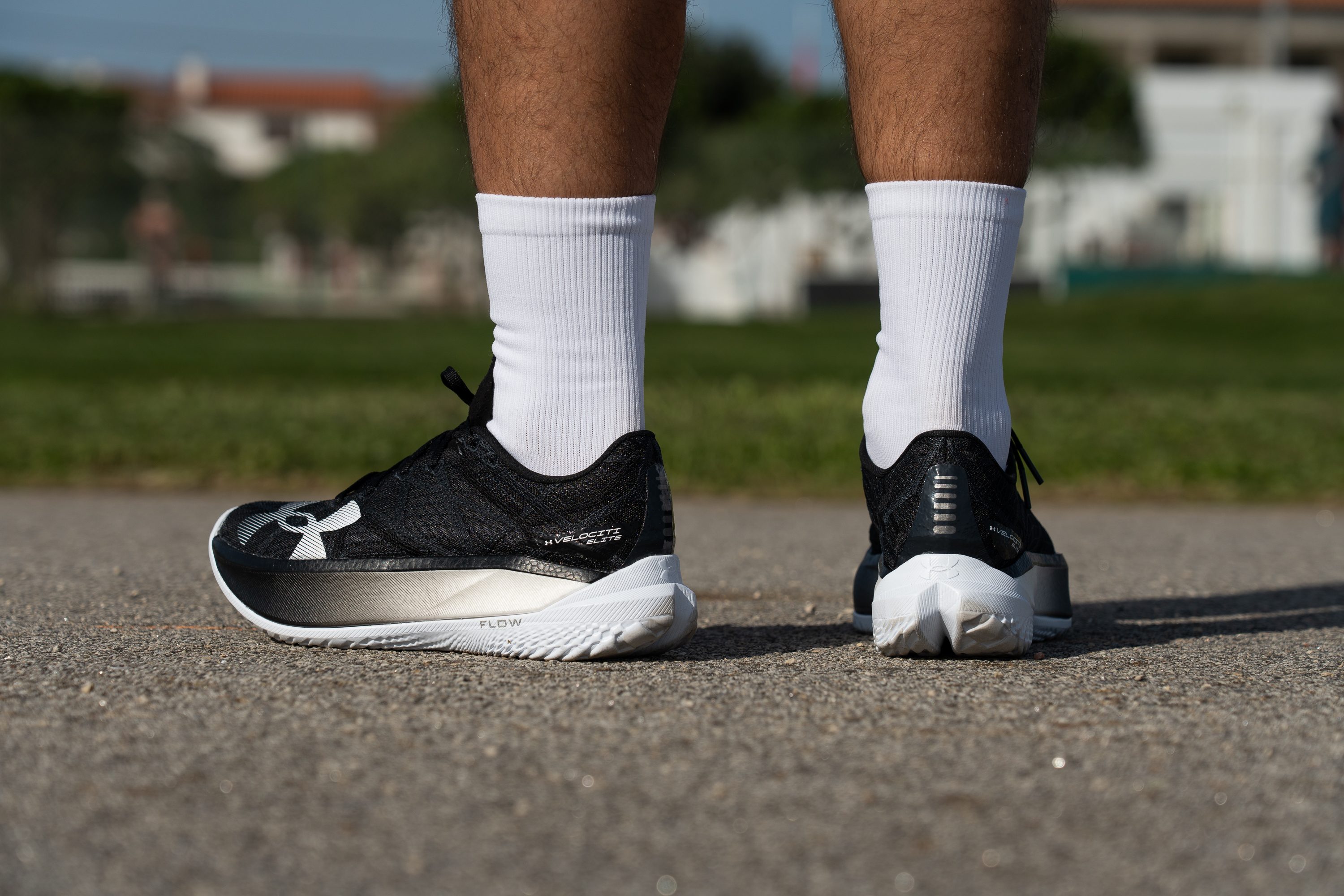
| Velociti Elite 2 | Ninguno |

